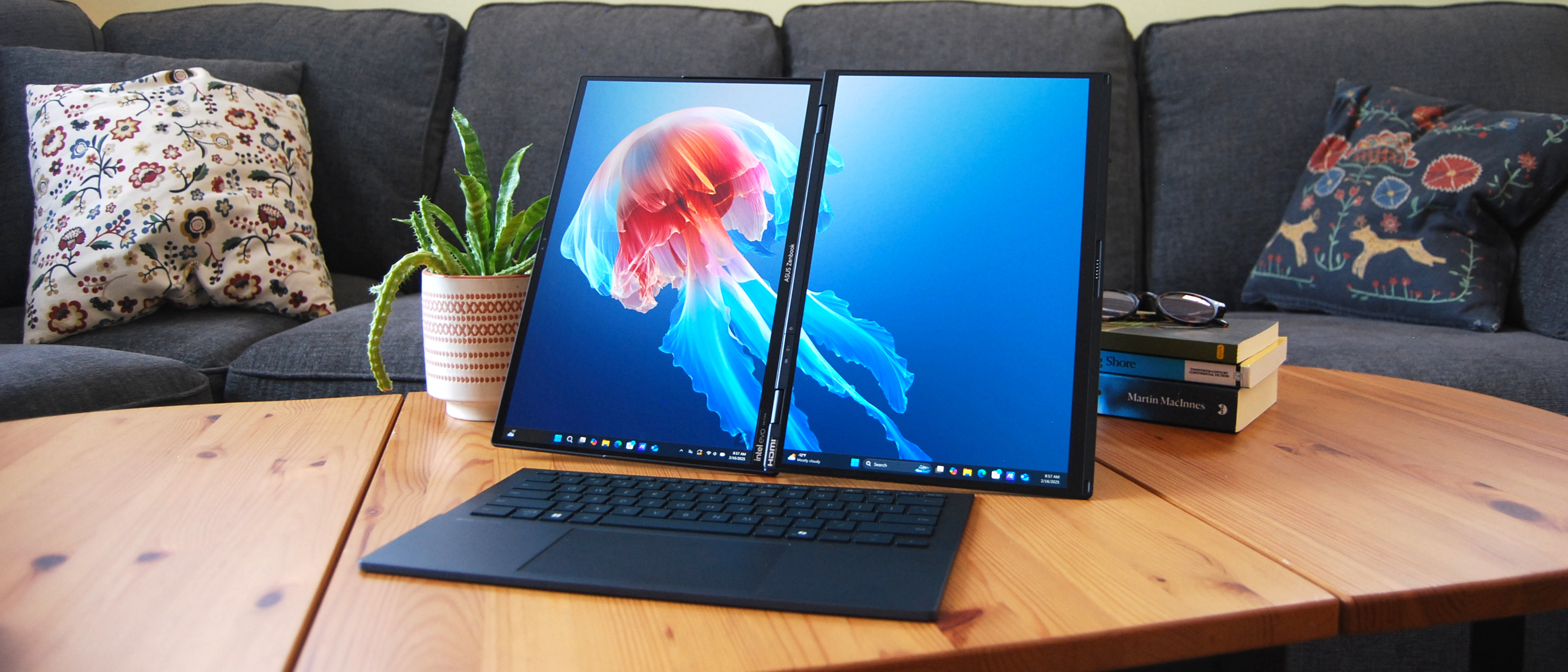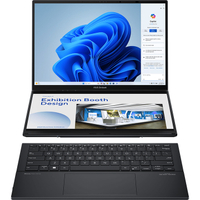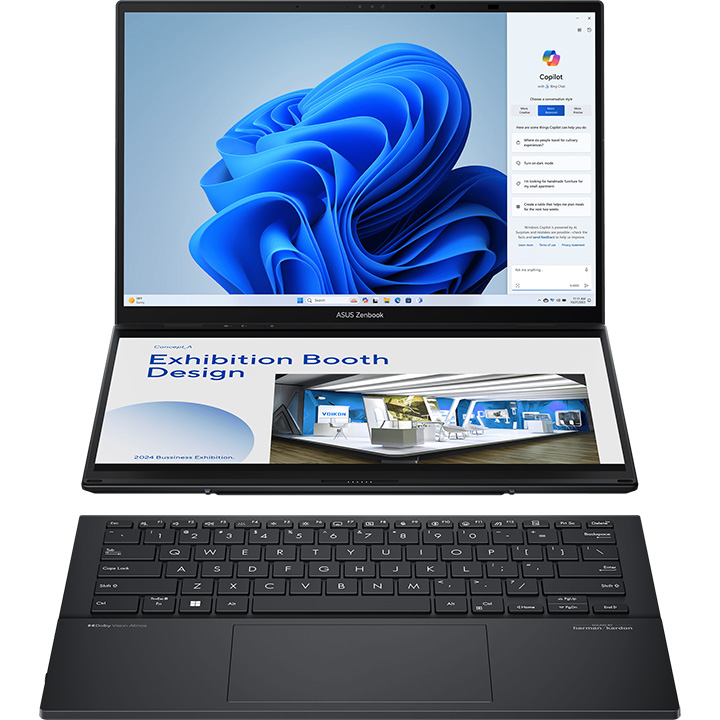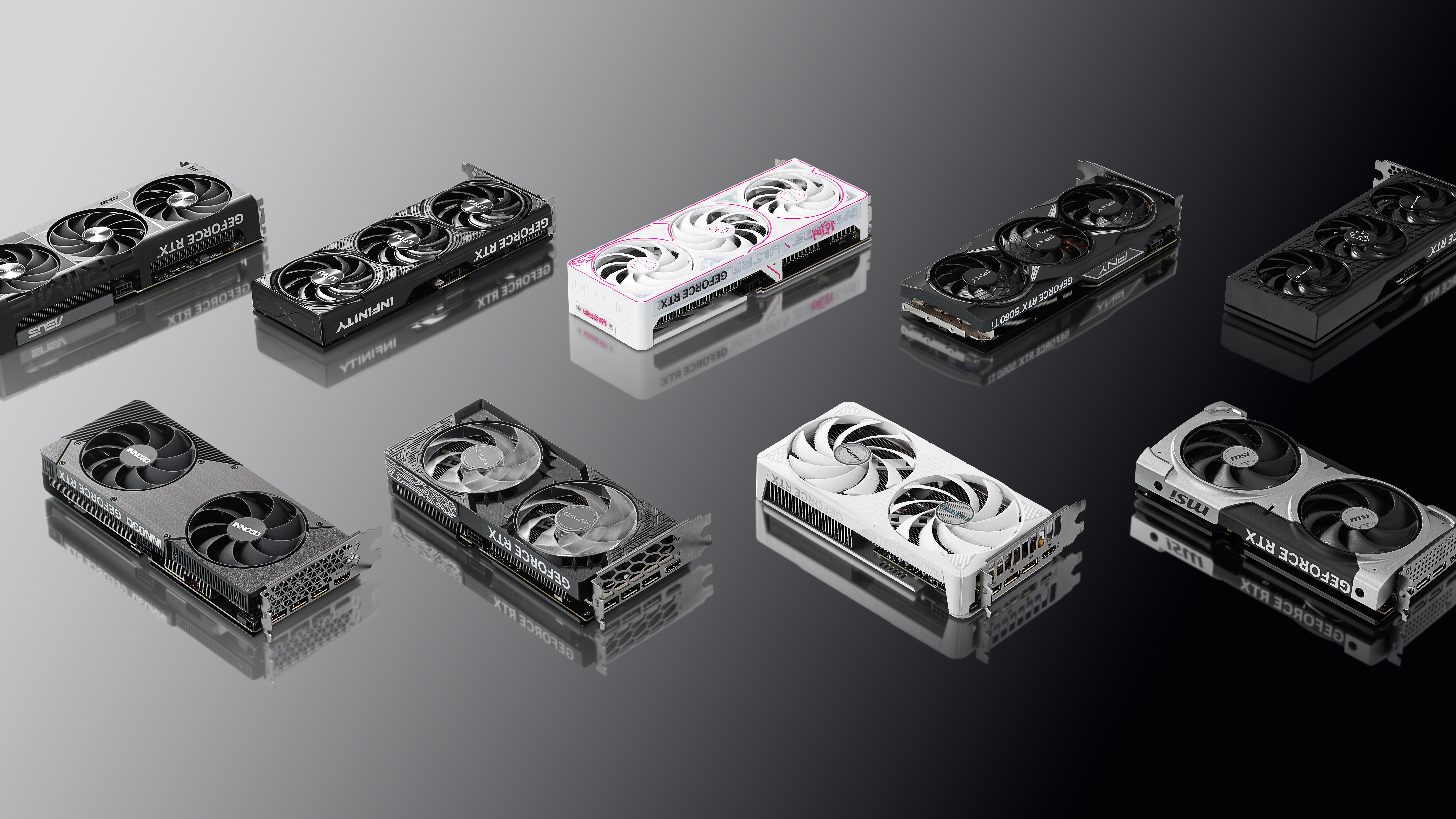Windows Central Verdict
The Zenbook Duo (2025) is every bit as good as its predecessor, and it's now more powerful thanks to Intel's "Arrow Lake" chips inside. Battery life remains stellar, the keyboard and touchpad are excellent, and the OLED displays are gorgeous. Its webcam and speakers are so-so, but the drawbacks pale in comparison to everything this unique laptop does right.
Pros
- +
Intel Core Ultra "Arrow Lake" H-series chips offer a meaningful boost to performance.
- +
Battery life has improved, hitting 11+ hours in "Best Performance" mode.
- +
Vibrant 3K OLED touchscreens are outstanding.
- +
Thoughtful dual-screen design is easy to operate and useful, metallic stand is sturdy.
- +
Useful selection of ports, including Thunderbolt 4
Cons
- -
1080p webcam still isn't great, lacks a privacy shutter
- -
ASUS ScreenXpert still has some issues with Windows 11 screen management
- -
Thicker and pricier than your average 14-inch laptop
Why you can trust Windows Central
ASUS absolutely floored me last year when it introduced the Zenbook Duo (UX8406) dual-screen laptop. Able to perform at the same level as a standard 14-inch laptop in terms of raw CPU power and battery life while offering two OLED touch displays, my colleague Ben Wilson gave it a full five stars and a Windows Central Best Award.
I (Cale) had the original Zenbook Duo (UX8406) in for testing last year at the same time as Ben, and I've now been entrusted to rewrite this review to cover the new Zenbook Duo 2025 model I received a few weeks ago.
ASUS hasn't made any major changes to the 2025 Zenbook Duo beyond a bump to performance hardware. The physical attributes and supporting features remain mostly the same, so I'll only point out where the laptop is different and how well the updates work. Otherwise, I'll let Ben Wilson's original opinion stand unless I disagree or have some extra insight to share.
The Zenbook Duo (UX8406) for 2025 ultimately remains the best dual-screen laptop on the market. There's nothing else that offers the same complete package that's easy and enjoyable to use as a regular laptop or as an expanded workspace. However, there are some caveats, and I'm eager to share details regarding Intel's "Arrow Lake" mobile H-series CPU performance. Let's get to it.
Recent updates
February 14, 2025: I've updated this review for the refreshed ASUS Zenbook Duo (UX8406) for 2025. This review was made possible with a review unit provided by ASUS. The company did not see the contents of the review before publishing. — Cale Hunt
Zenbook Duo UX8406 (2025): Price, availability, and specs
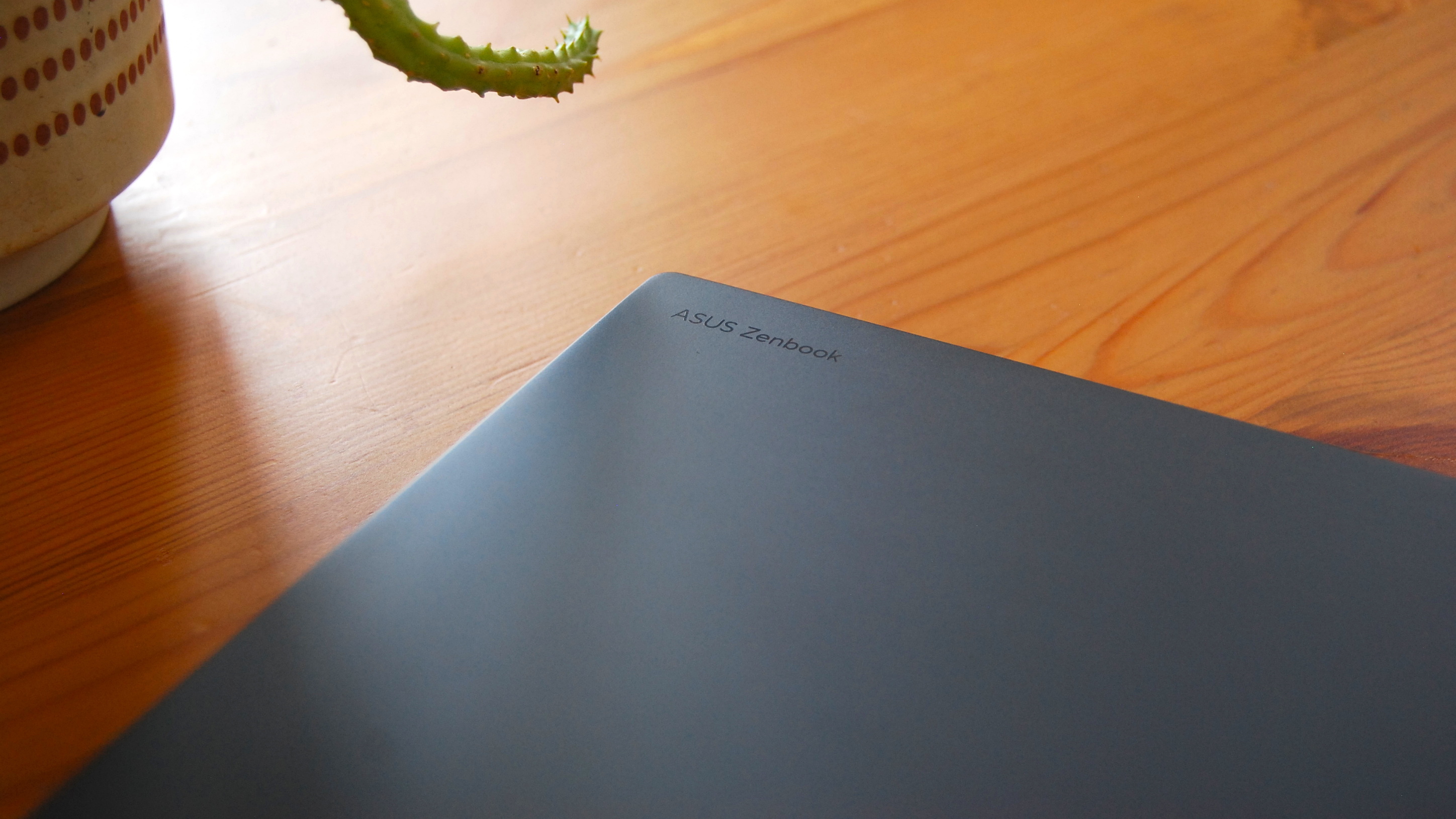
Price: From $1,599.99 at ASUS; $1,699.99 as reviewed
CPU: Intel Core Ultra 9 285H
RAM: 32GB LPDDR5X
GPU: Intel Arc 140T
Storage: 1TB PCIe 4.0 NVMe SSD
OS: Windows 11 Home
Camera: FHD IR with Windows Hello
Displays: 2x 14-inches, 2800x1880, OLED, 120Hz refresh rate, touch, 0.2ms, 500nits w/ HDR, stylus support
Ports: 1x USB-A 3.2 Gen 1, 2x Thunderbolt 4 USB-C w/ PD, 1x HDMI-out 2.1, 1x 3.5mm combo audio
Connectivity: Wi-Fi 7, Bluetooth 5.4
Battery: 75Wh
Charger: 65W USB-C, 20V DC, 3.25A
Dimensions: 12.34 x 8.58 x 0.57-0.78 inches (31.35cm x 21.79cm x 1.46-1.99cm)
Weight: 3.64 pounds (1.65 kg)
As with the 2024 model, ASUS sells two variants of the Zenbook Duo (2025) at its official storefront. It's expected that it will branch out to third-party retailers in the near future; the 2024 Zenbook Duo is still available at Best Buy, usually at a discount.
Whereas the older models started at $1,500, the 2025 models now start at $1,600. I considered the 2024 price a real steal, and the $100 increase isn't meaningless. ASUS seems to have done away with the FHD+ (1920x1200) screens in the Core Ultra 7 models, so you're essentially paying an extra $100 for an upgrade to 3K (2880x1800) OLED. That's not bad at all.
The baseline model — UX8406CA-DS79T — includes an Intel Core Ultra 7 255H CPU, 32GB of LPDDR5x RAM, 1TB M.2 PCIe 4.0 NVMe SSD, and dual 3K OLED touch displays.
There's better news for those who want the more powerful Core Ultra 9 285H model (UX8406CA-PS99T). It still costs about $1,700, which is in line with 2024's pricing. It otherwise has the same specs as the Core Ultra 7 255H model, and the price increase rides fully on the more powerful Intel CPU.
Whichever you choose, you'll have access to Intel's AI Boost Neural Processing Unit (NPU) for handling dedicated AI tasks. Integrated Intel Arc 140T chips handle graphics, and they represent a significant improvement compared to the integrated GPUs in Intel's Series 1 CPUs used in the 2024 Zenbook Duo.
Recommended configuration
Ready-made and matching my sample unit, I don't see any reason to recommend any sacrifices in specifications. Featuring Intel's Core Ultra 9 285H CPU, 32GB of RAM, and 1TB SSD, it costs about $1,700 at ASUS.
Zenbook Duo UX8406 (2025): Design and build quality
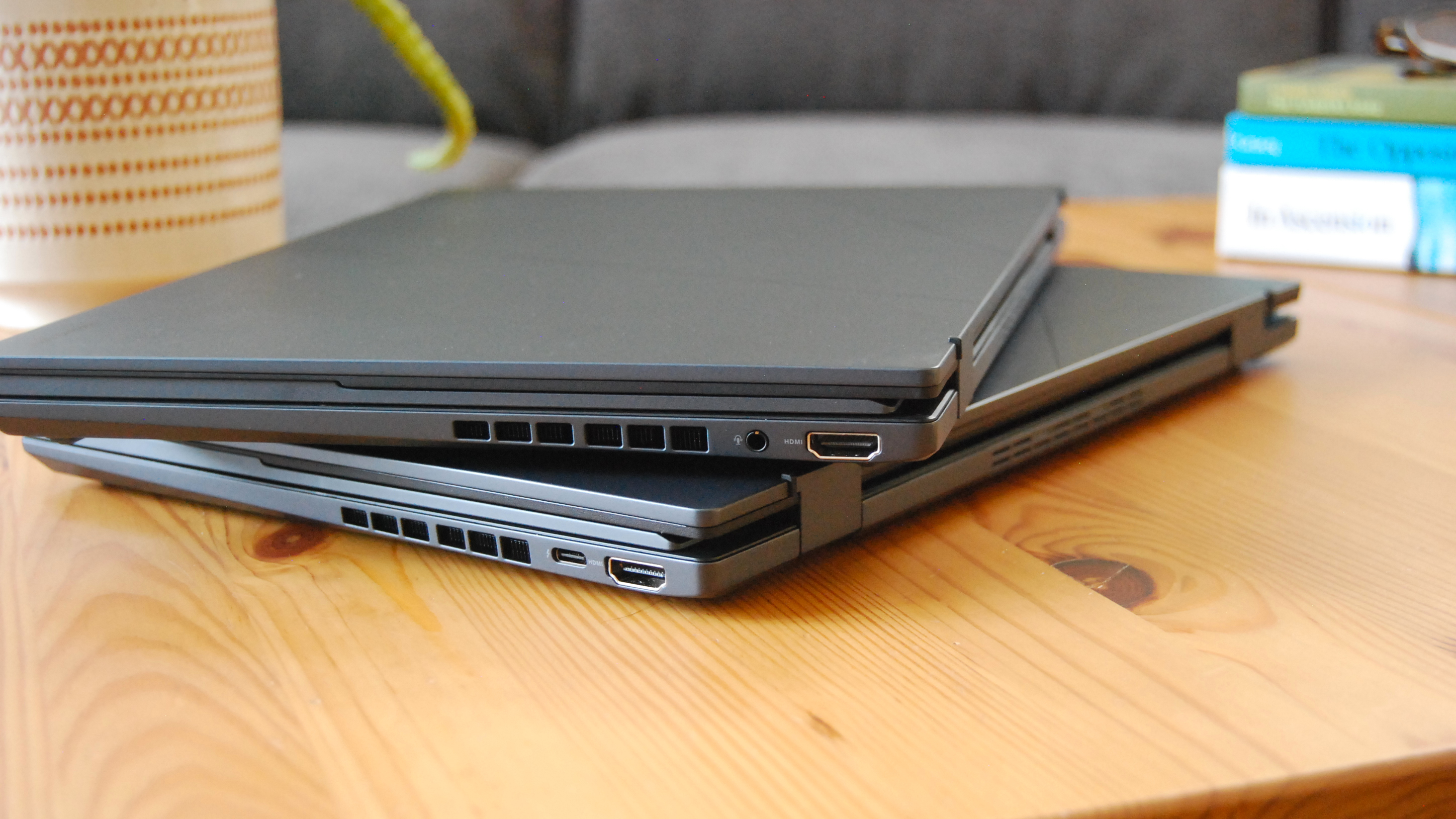
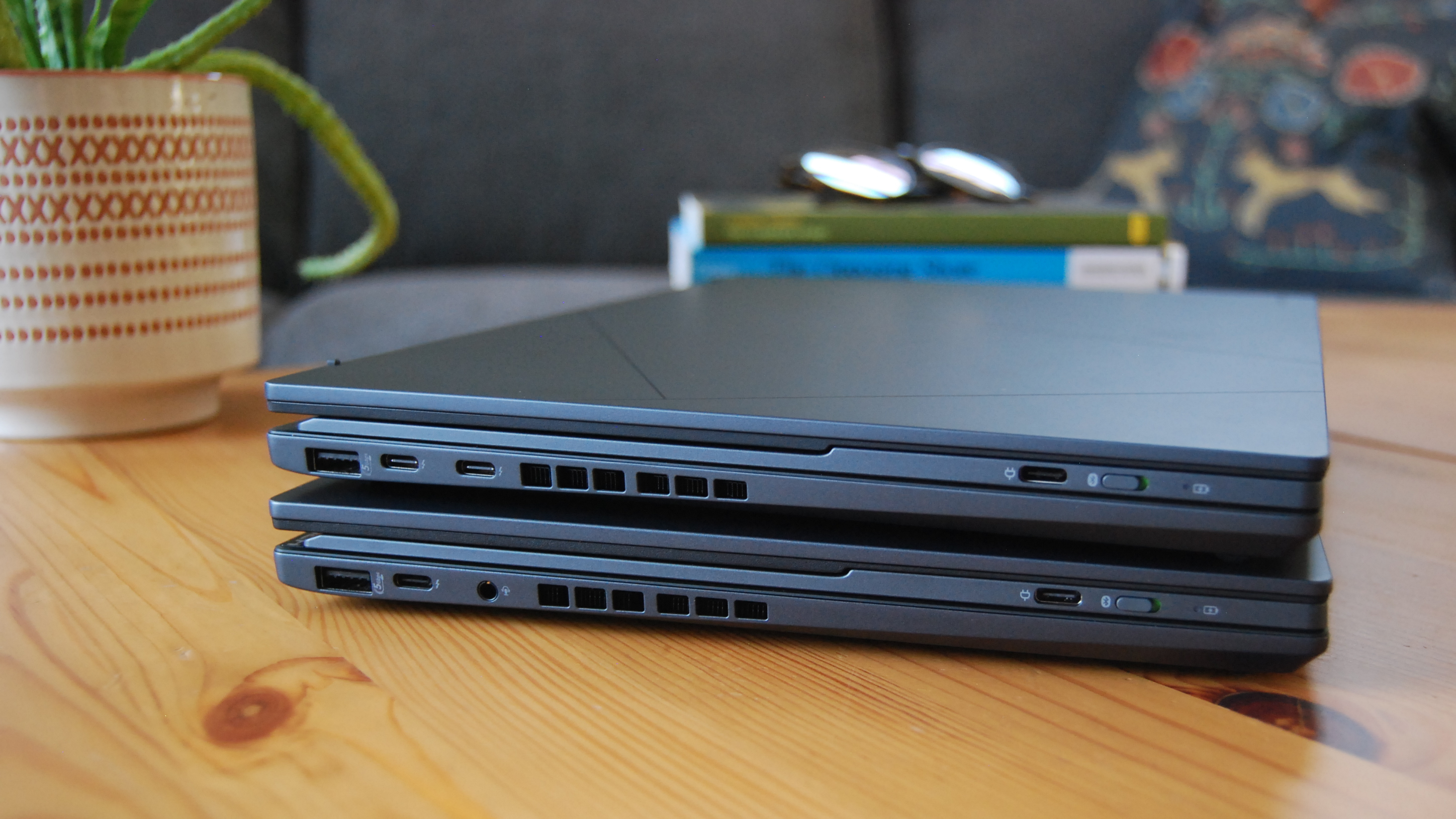
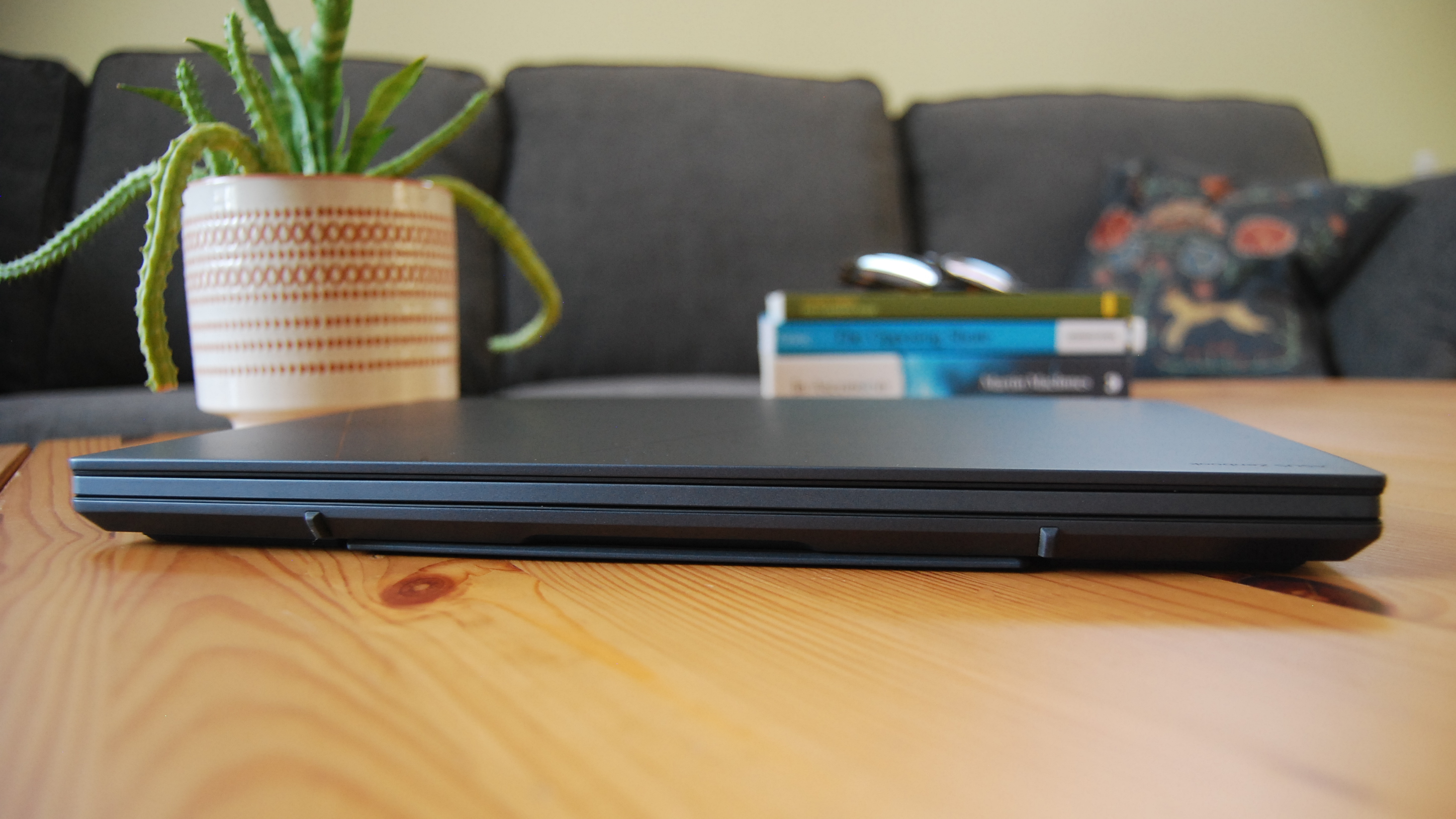
The most striking feature that sets the Zenbook Duo apart from other laptops I've used, at least in its default configuration, is the chunky bottom half. This is due, of course, to the unique design that sees a detachable keyboard and trackpad combo sitting atop the secondary 14-inch OLED display. A built-in metal stand that folds out when needed is on the bottom of the laptop. It certainly adds to the weight and thickness, but it's well worth it.
Opening the screen beyond ~110 degrees raises the laptop slightly at the rear, helping with airflow and leaving more space for the down-firing speakers to resonate against a desk. The slight incline also helps typing feel a little more comfortable. I've been using the Zenbook Duo to write articles for the past few days, and I'm still as much of a fan of the keyboard as I was last year.
I love typing on this laptop, and you make no sacrifices for the extra display.
ASUS achieved something special with the keys. The detachable portion is barely 7mm (0.27 inches) thin and weighs just 312g (0.68 pounds), yet it's rigid enough that you can type with it on your lap, detached from the rest of the laptop.
The keys somehow have a comfortable 1.4mm of travel and a backlight, while the Precision touchpad is large and accurate with a satisfying click. I love typing on this laptop, and you make no sacrifices for the extra display.
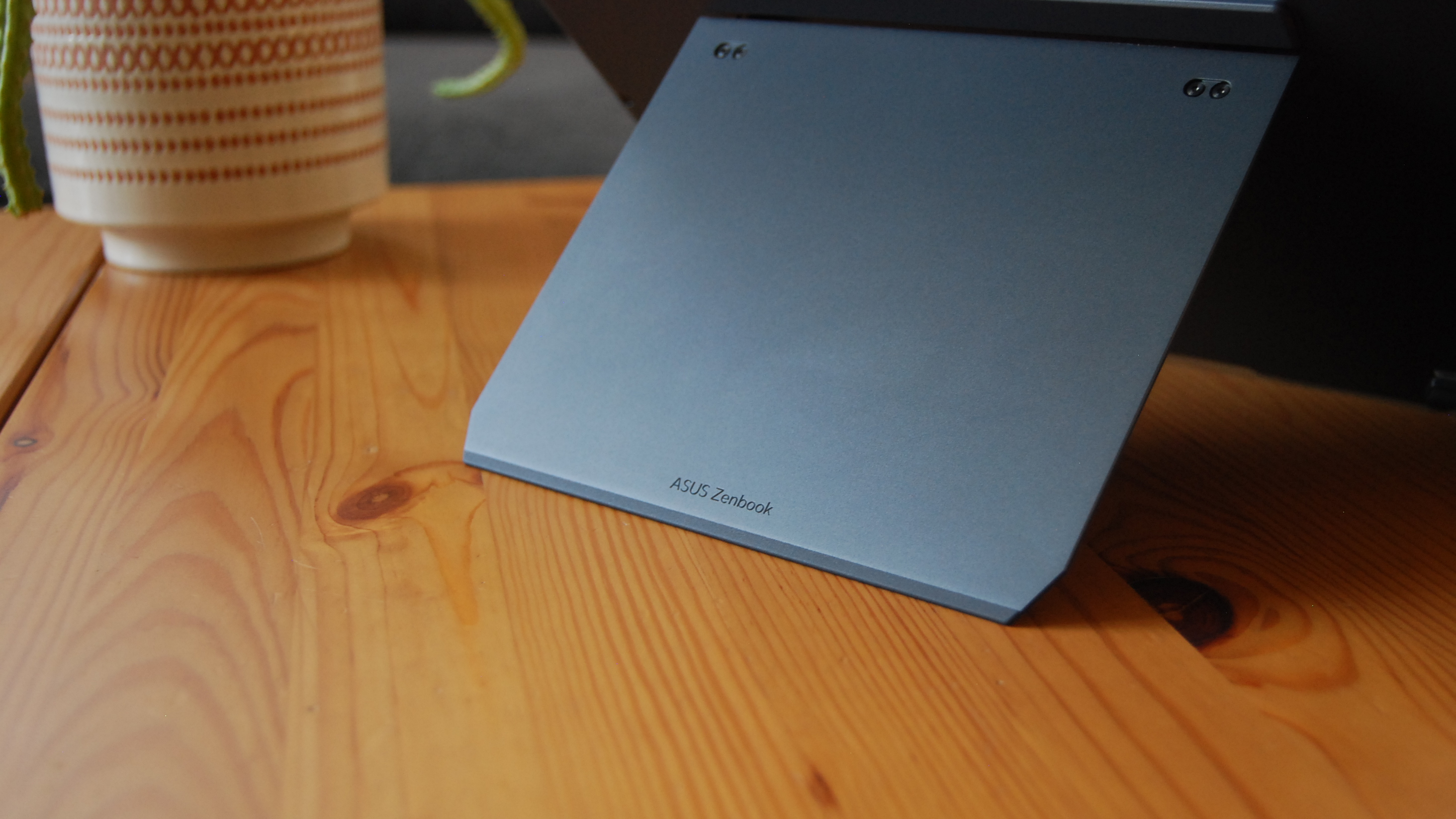
The 2025 ASUS Zenbook Duo is built every bit as well as the 2024 model. The hinges are firm, all the moving parts line up nicely, and it's not so heavy or chunky that it leaves me wishing I'd stuck with a single-screen setup. Around the outer chassis, it opts for a subtle design of sharp lines and a tiny logo, and I dig it.
The bottom of the laptop is covered mainly by the fold-out stand, with a relatively small area reserved for intake venting. This undoubtedly impedes the top-end performance, especially in the Core Ultra 9 models, as I discuss in the Performance and Benchmarks section.
Exhaust venting is found on either side of the laptop, directed out and away from the PC. You might feel it on your hand if you're using an external mouse, but it's better than having it blocked by your legs.
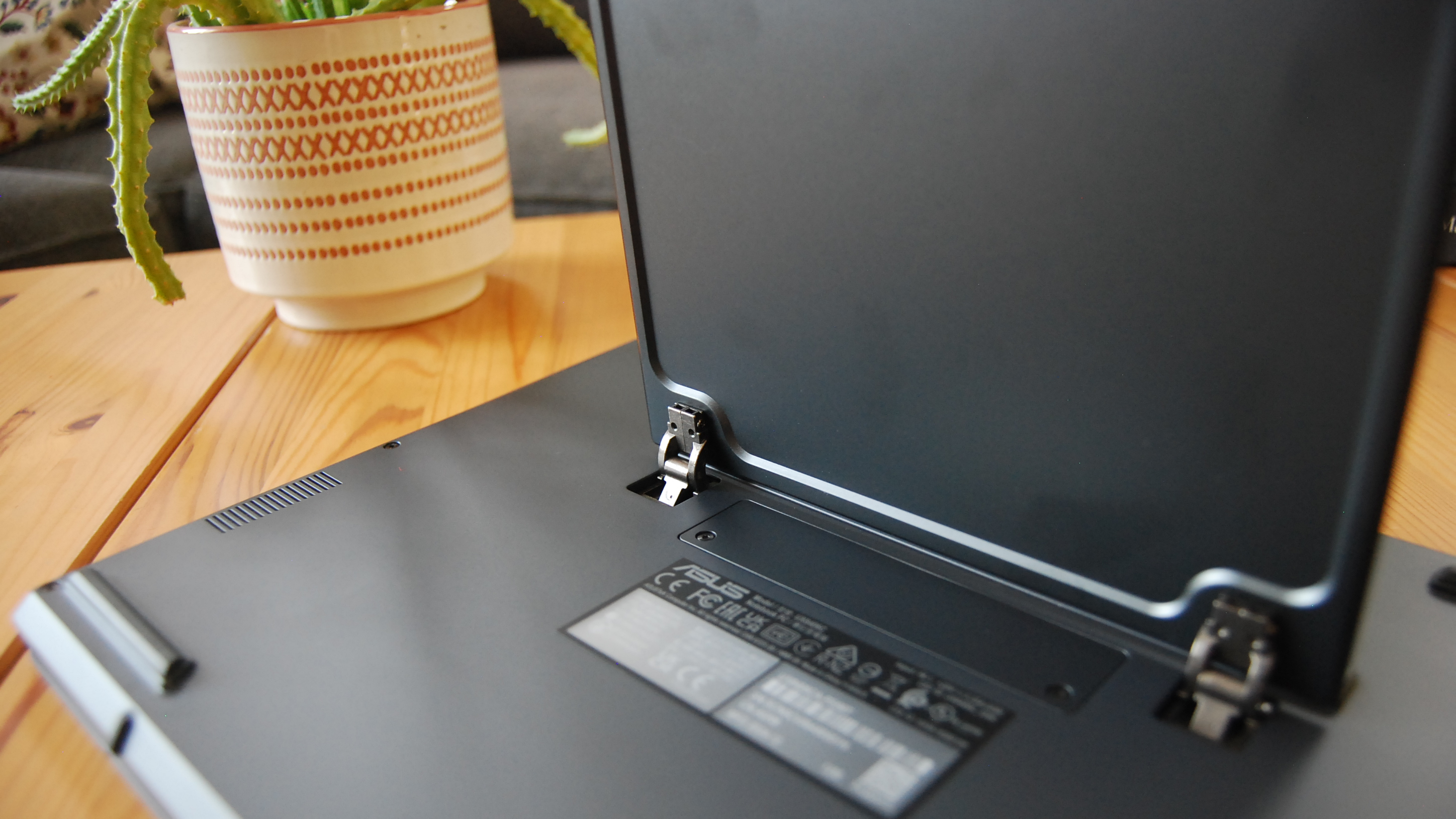
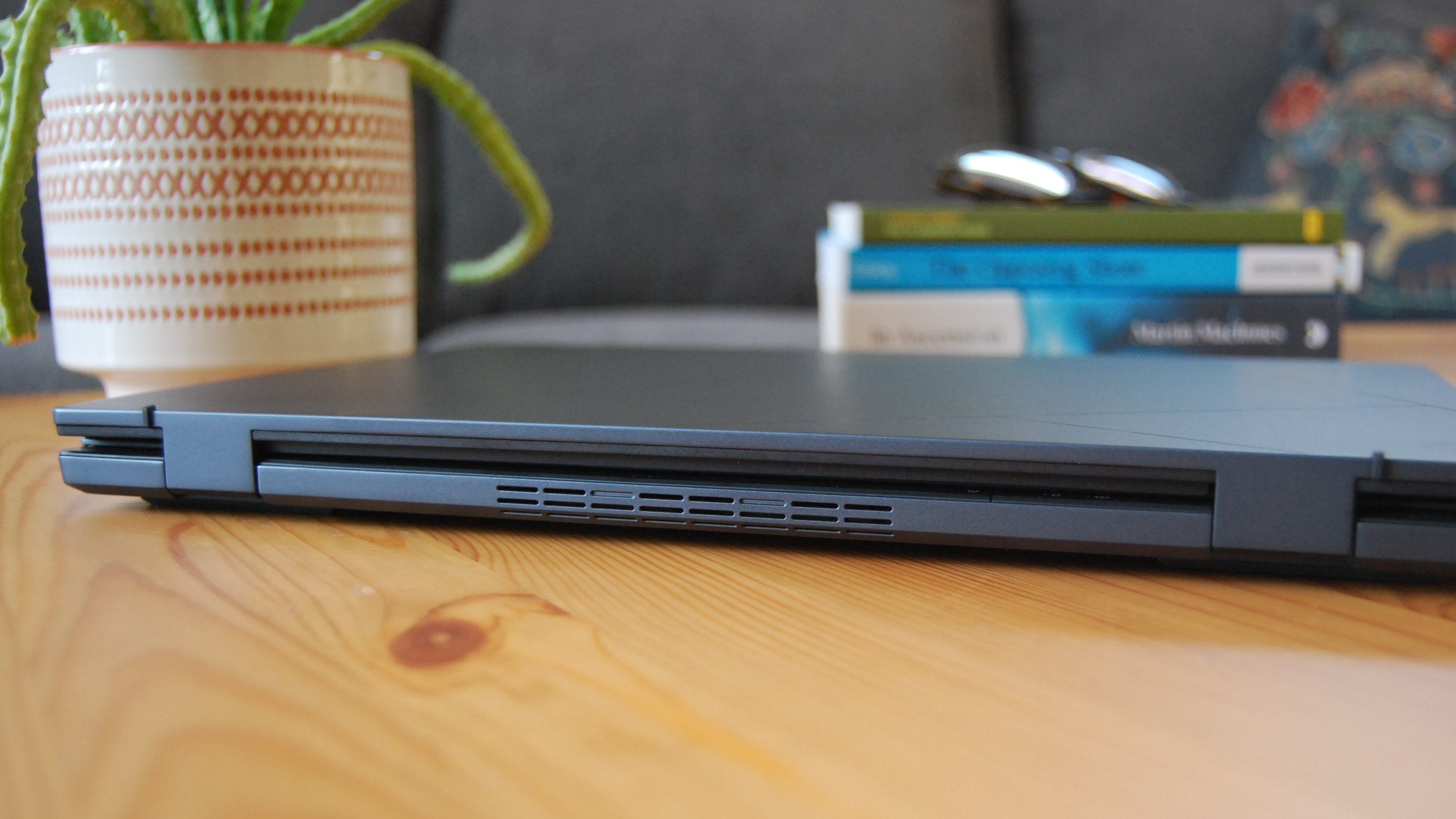
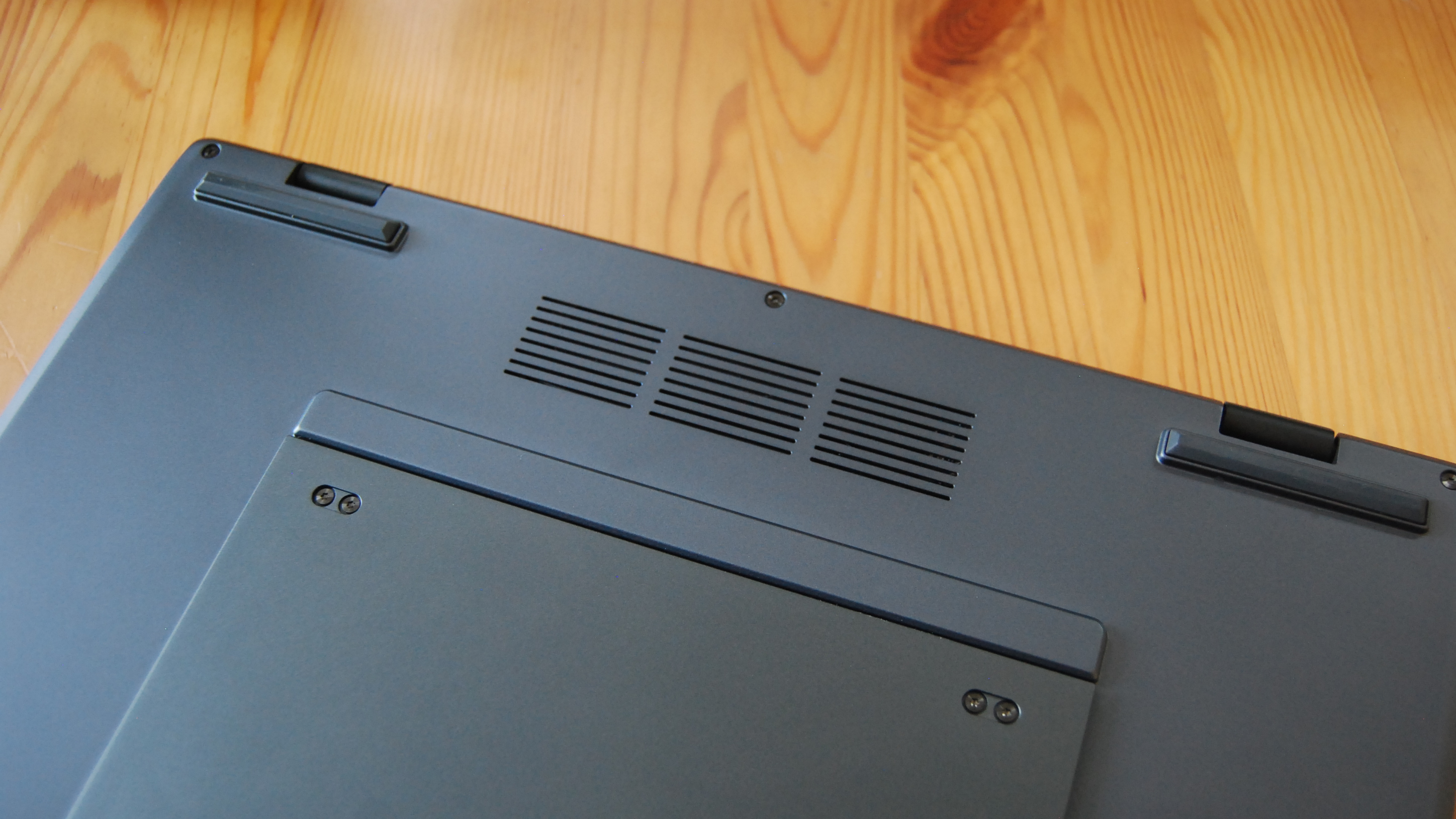
Port selection remains the same as last year, though positioning has changed. The dual Thunderbolt 4 ports are now split — one for each side — making it a lot easier to charge or connect accessories. The 3.5mm audio jack and a USB-A 3.2 (Gen 1) port also take up residence on the left. An HDMI 2.1 port joins the Thunderbolt 4 input on the right side.
Hooking up any of the best Thunderbolt docks will open up avenues for more traditional USB-A ports and other extras if you need them at a desk.
ASUS skipping an Ethernet port wasn't a deal breaker before, and it certainly isn't now that the Zenbook Duo (2025) has been upgraded to Wi-Fi 7. Bluetooth 5.4 support also means most wireless mice won't need a USB dongle, and cable-free headphones allow for low-latency listening.
Zenbook Duo UX8406 (2025): Dual-screen modes
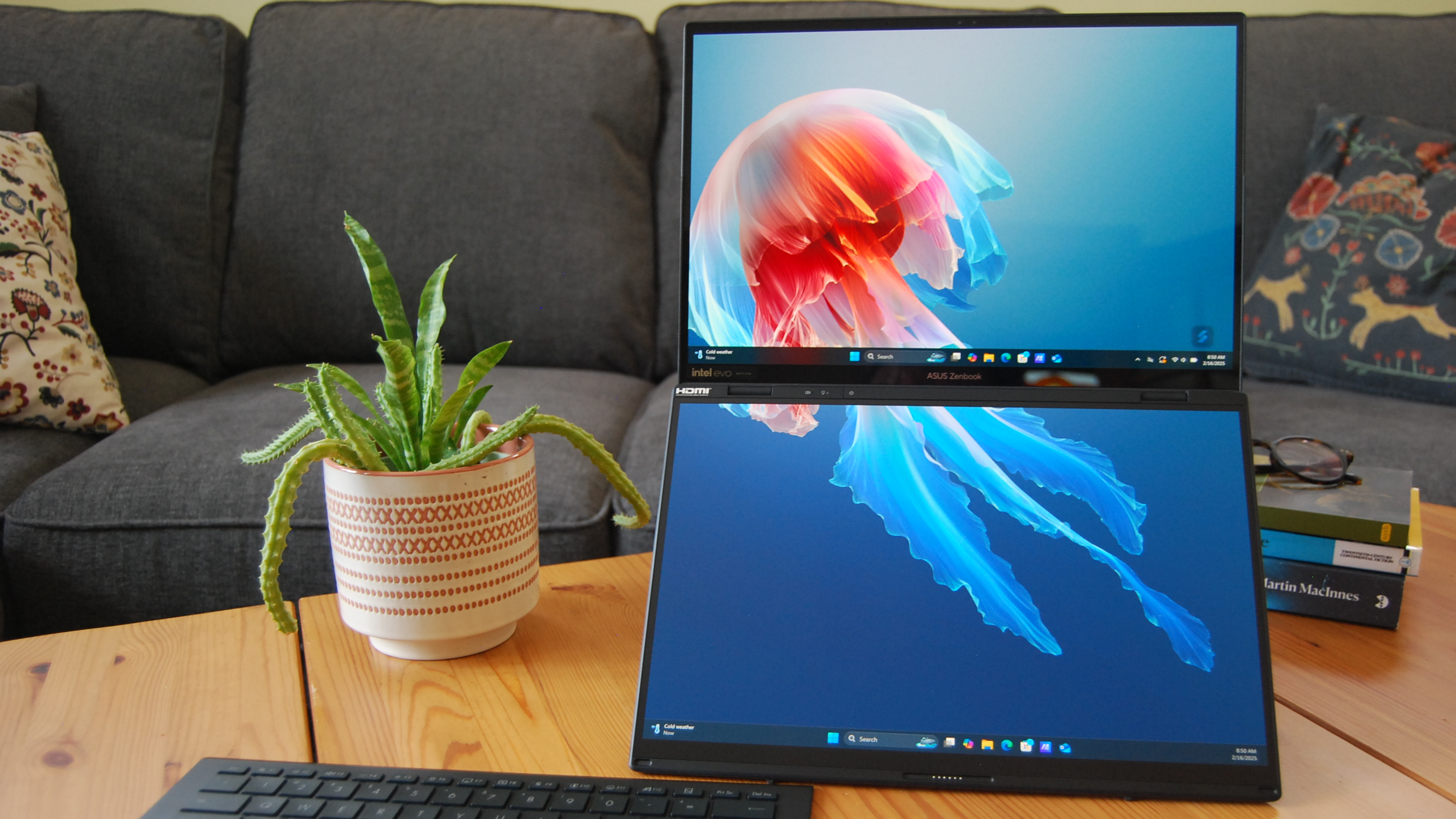
Once I cleared a little desk space, I immediately set the Zenbook Duo into one variant of what ASUS officially names 'dual screen mode.' Technically, the first type uses the lower OLED touchscreen as a virtual touchpad and keyboard. Still, if you're detaching the physical Bluetooth keyboard anyway, you might as well use it unless you want to input some handwriting with an additional ASUS Pen 2.0 stylus, which may or may not be included in the box, depending on your region and retailer.
The Bluetooth keyboard is held in place by magnets and charging connectors, and the entire underside is coated in an ultra-smooth plastic finish to protect the lower screen. There's no danger of it coming detached in an accidental knock, as the magnets are strong almost to the point of excess. It's not a genuine struggle to remove, but it holds on tight for something intended to be regularly detached for convenience. Nevertheless, if you have enough desk space to set the Zenbook Duo up this way, you might fall in love with it as quickly as I did.
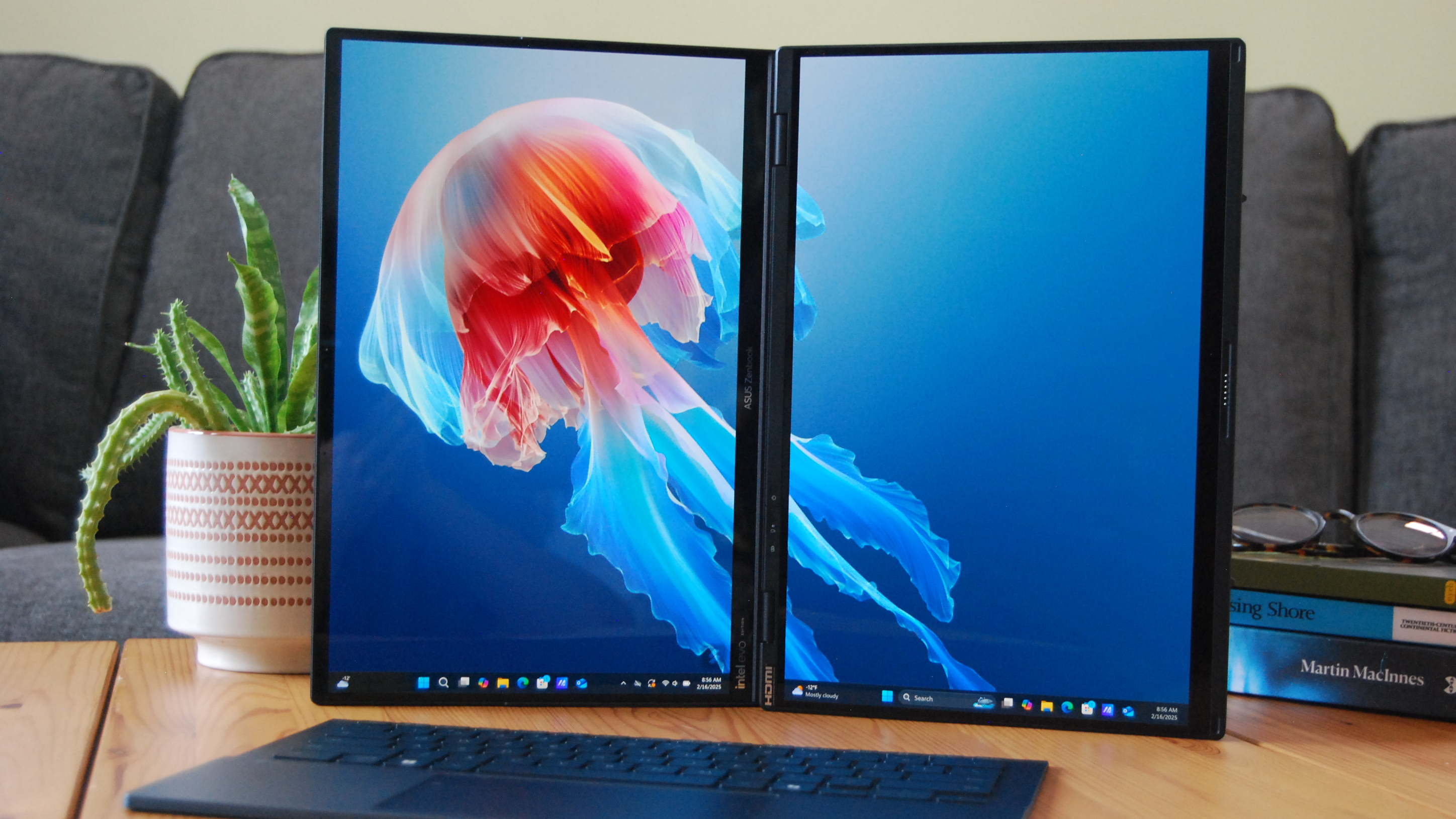
I often use traditional laptops with a cheap external kickstand to elevate the display to a comfortable height that matches my eye level. In the long run, this protects the health of my neck since I'm not staring downwards at an uncomfortable angle most of the time. ASUS offers the same solution in the dual-screen mode, at least if you use the top screen to monitor your most focused applications. Along the bottom screen, I store quick notes, messaging apps, or web pages open in Microsoft Edge tabs for reference. Immediately swapping the contents of screens 1 and 2 can be done with the F7 key, too.
Since the built-in kickstand is so incredibly sturdy, it doesn't feel unnerving to set the Zenbook Duo up in dual-screen mode, as I suspected it might. Its 14-inch OLED panels are gorgeous, but would I want to position them in a way that looks unusually precarious in ASUS' ad campaigns? It turns out to be a non-issue, and the hinge connecting both screens holds extra tight, which helps to prevent shakiness. Sure, on a particularly rough train journey or a shaky flight, you'll likely want to push the top screen back against a solid surface, but on a desk, it's perfect.
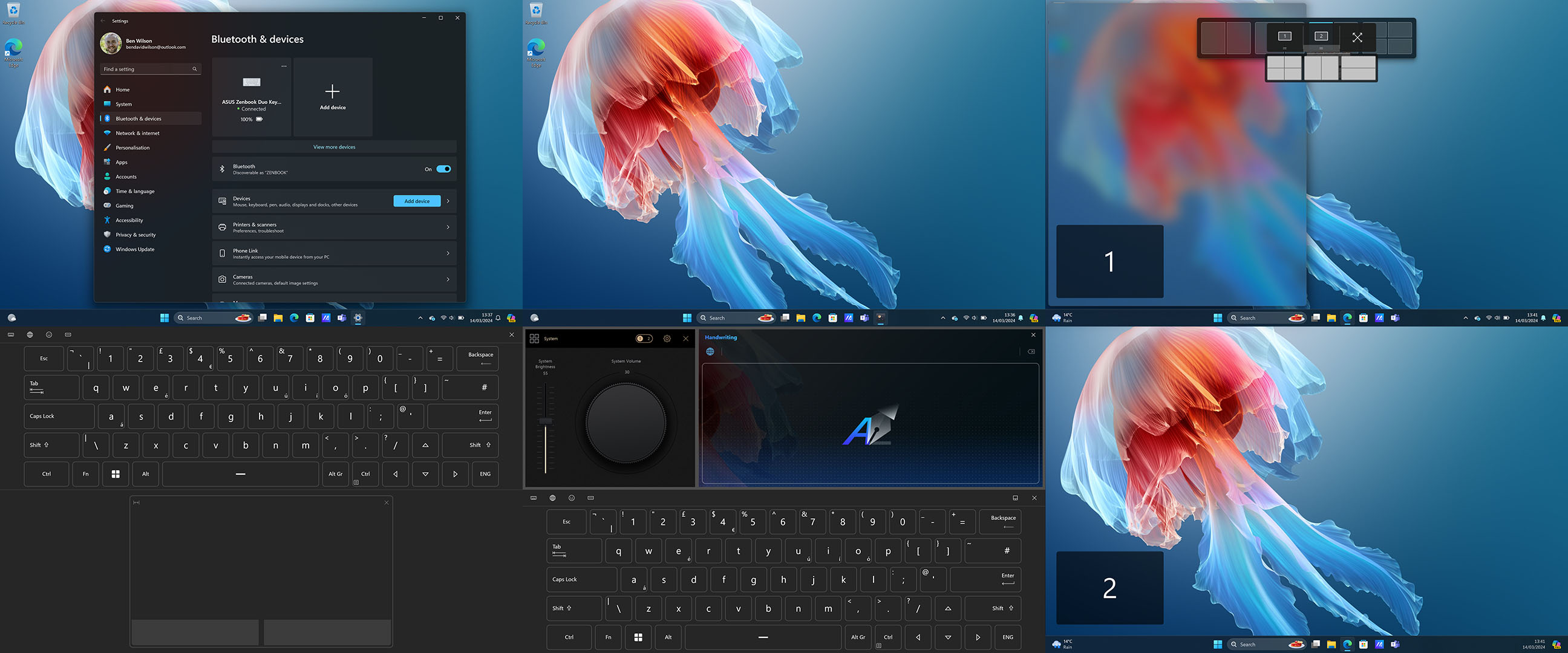
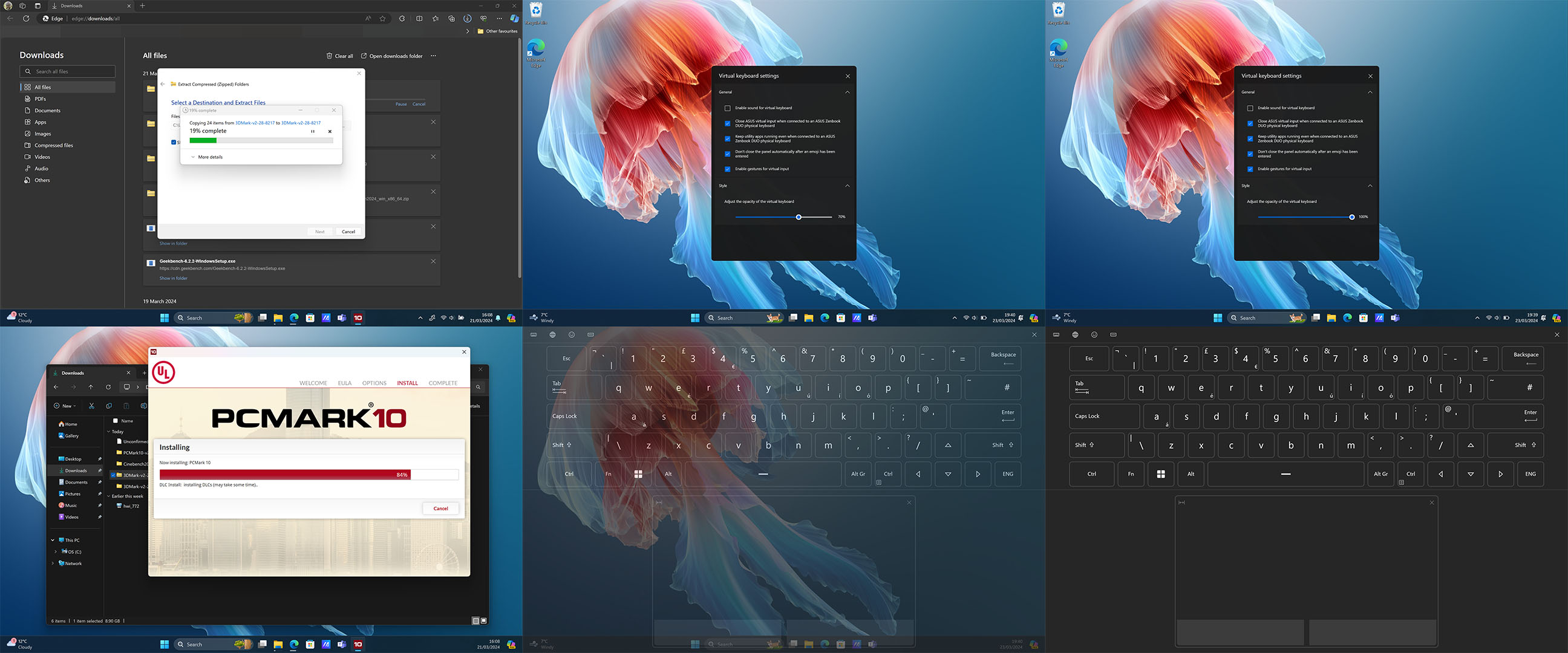
Setting the Zenbook Duo into a side-by-side 'desktop mode' feels far less intuitive, though it has some implied uses. ASUS claims this layout is "perfect for programmers, researchers, and writers," which should appeal to me, but it doesn't hold a candle to its vertical dual-screen modes. For one, the kickstand doesn't reach the left and right edges of the chassis underside, so unless you bring an external solution, there's far more danger of accidentally toppling the laptop over like a dense newspaper.
Vents are placed on both sides of the laptop to help cycle hot and cool air inside, and one of those will undoubtedly be blocked in this mode, if only partially. Plus, depending on your chosen orientation, you'll lose access to either the collection of USB ports or the HDMI-out when standing the laptop on a desk. You could hold the Zenbook Duo like a magazine in this mode, but you'll need somewhere to store the detached Bluetooth keyboard, which isn't particularly convenient. I own a stand that doesn't block the vents, and while it's a fun experience to have two vertical monitors in this mode, it's nowhere near as functional or practical.
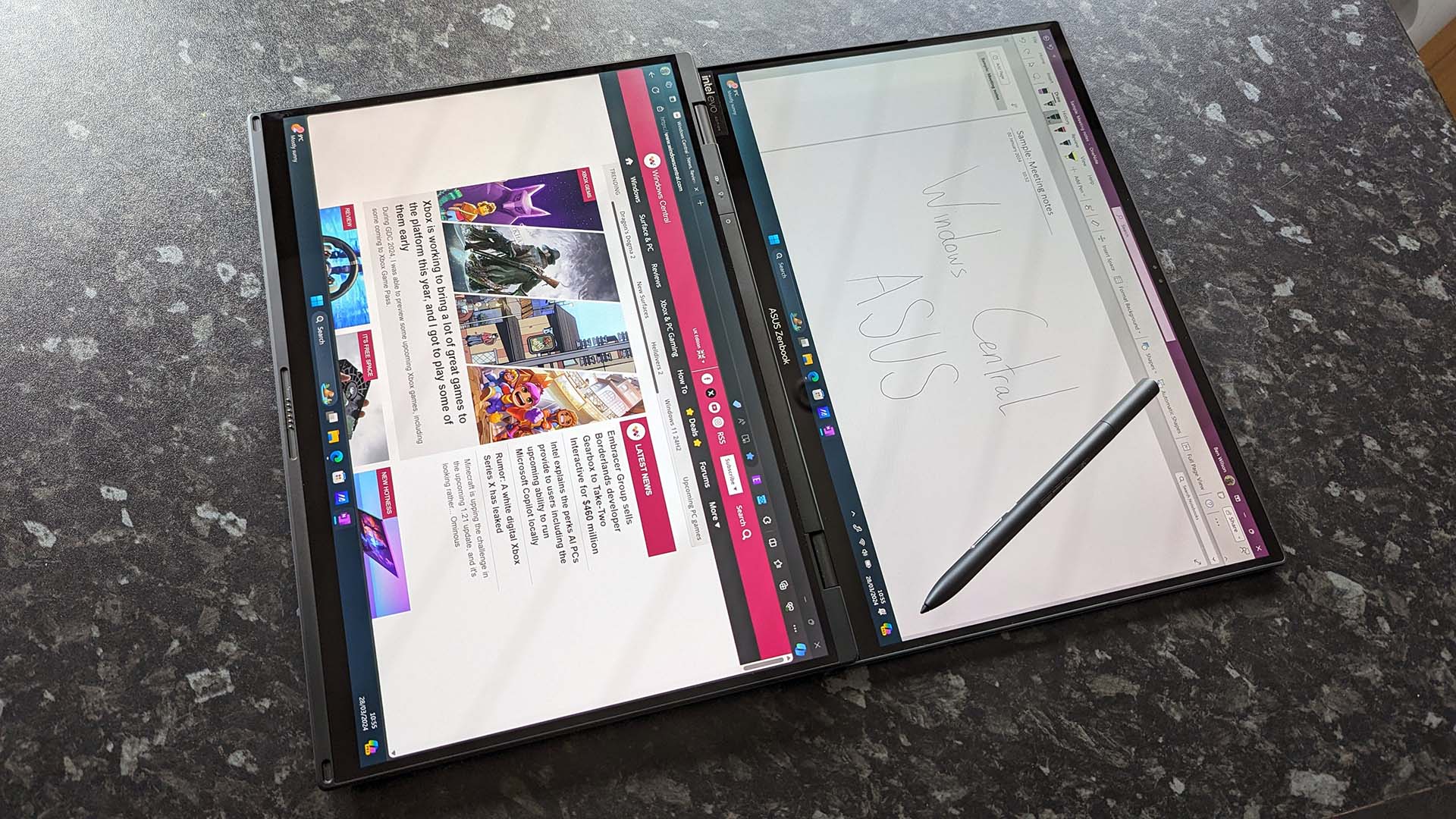
Finally, 'sharing mode' is exactly what it sounds like. The Zenbook Duo can open to 180° and lay flat on a table, essentially geared around intimate presentations among a small group. It won't ever replace the traditional environment of presenting a PowerPoint slideshow with a wall-facing projector, but having both touchscreens available to a few colleagues huddled around and interacting with your content is a great way to get your point across in a hurry. This is where the ASUS Pen 2.0 stylus shines the most, whether casually highlighting documents or handwriting lengthier scripts in the mode most resembling a traditional tablet.
Overall, the dual screen mode is the best way to use this laptop, completely matching ASUS' marketing and Duo namesake. The only real-world downsides relate to minor gripes with ASUS ScreenXpert getting stuck behind the native Windows 11 window-snapping prompt when you're trying to arrange your apps quickly, which can be frustrating. Otherwise, bringing up the on-screen keyboard or handwriting field can be selective with the six-finger prompt, but once it's up, it's a reasonable method to input short amounts of text.
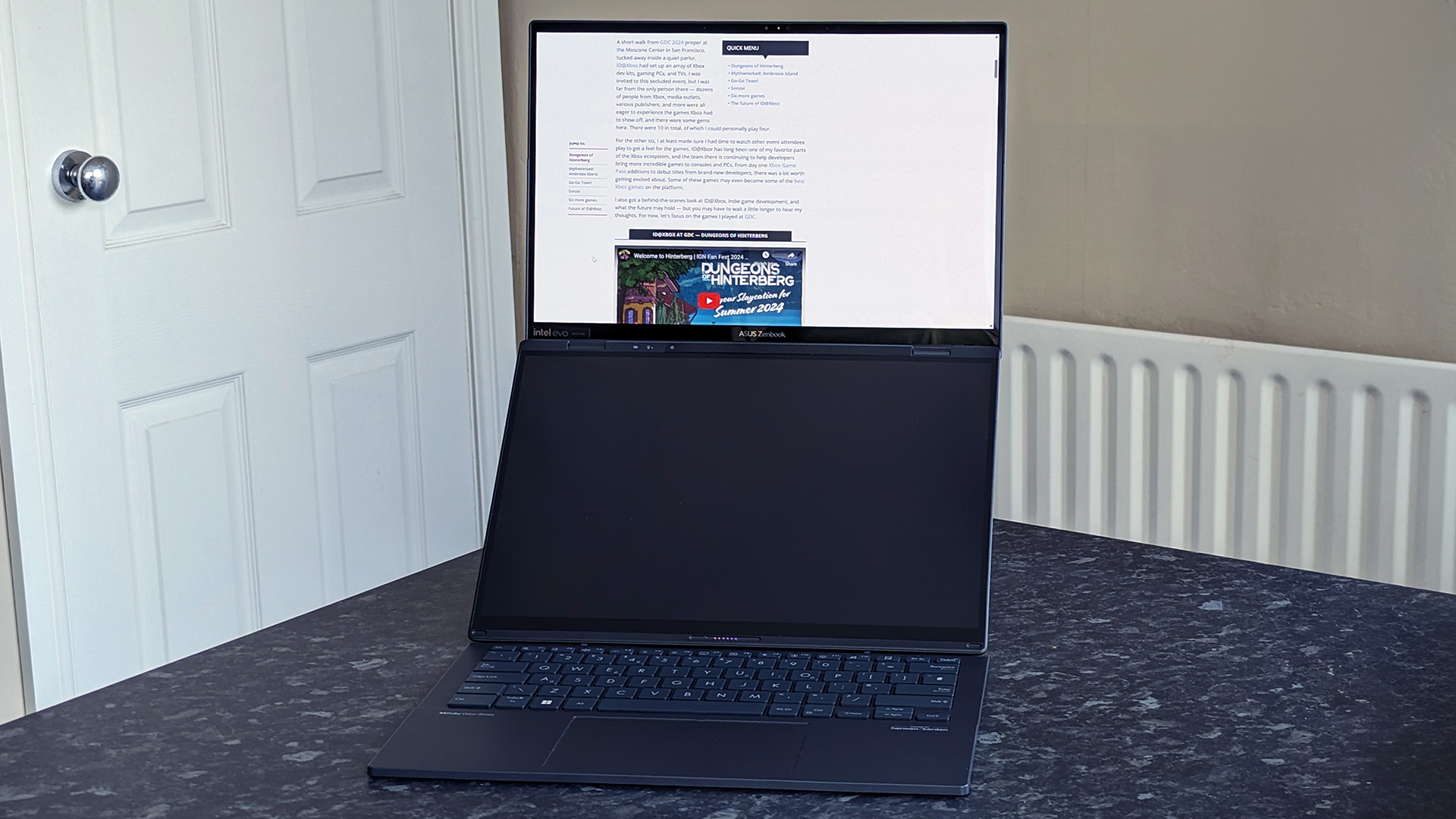
Finally, for an unusual yet beneficial layout that ASUS doesn't explicitly highlight, you can deactivate the bottom screen with a shortcut button along the top row to the right of F12, which takes a couple of seconds for Windows 11 to recognize. It's nothing rapid but sets up what I'd consider a battery-conscious configuration that retains the ergonomic eye-level position with its top screen. You're unlikely to switch this mode on and off in a hurry anyway, so the slight delay in activation is no big deal, and it ends up being one of my favorites.
Zenbook Duo UX8406 (2025): Performance and benchmarks
ASUS sent me a temporary review unit packed with the best hardware on offer, including Intel's new "Arrow Lake" Intel Core Ultra 9 285H CPU with 16 cores, 16 threads, and a 45W TDP. It's one of the most recent additions to Intel's modern mobile lineup, with promises of a capable integrated GPU and reliable performance on or off the AC charger.
As Windows Central Staff Writer Zachary Boddy remarked in their focused Core Ultra 9 285H review, it's "a very capable performer with an especially impressive iGPU, and it won't smash your battery to pieces to achieve that performance."
However, those hoping to land an AI PC with Copilot+ abilities will be disappointed. Whereas AMD and Qualcomm are focused on adding powerful Neural Processing Units (NPU) to their latest chips, Intel has split its lineup. H-series "Arrow Lake" chips like the one in the new Zenbook Duo do not have Intel's most powerful AI Boost abilities, instead falling back to an NPU with about 13 TOPS of power. With a 45 TOPS minimum for Windows 11's built-in AI tools, the Zenbook Duo won't be making the list of best Copilot+ PCs anytime soon.
Does that really matter? It depends on how you use the PC. I still haven't found a "killer" tool that really makes Copilot+ access worth it, but you might have a different opinion. In this case, the Zenbook Duo's dual-screen setup and battery life are a lot more important than a powerful NPU.
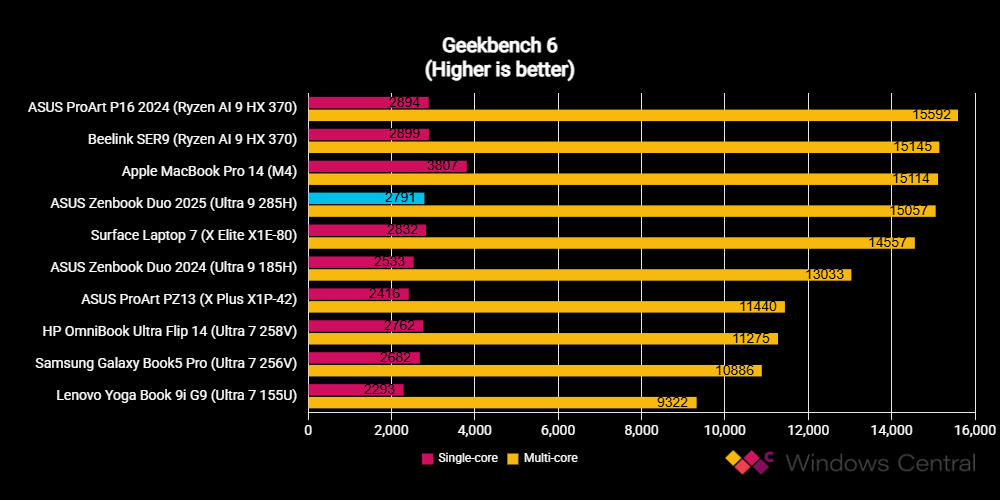
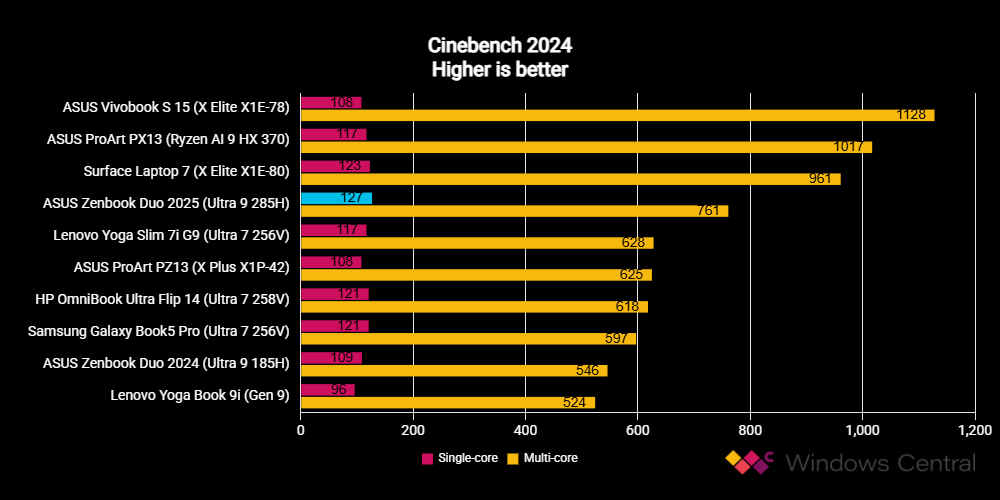
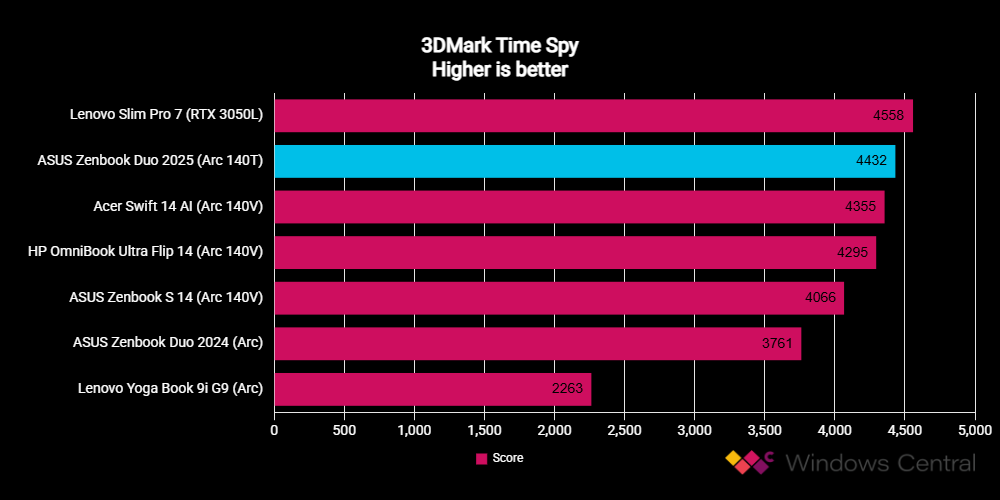
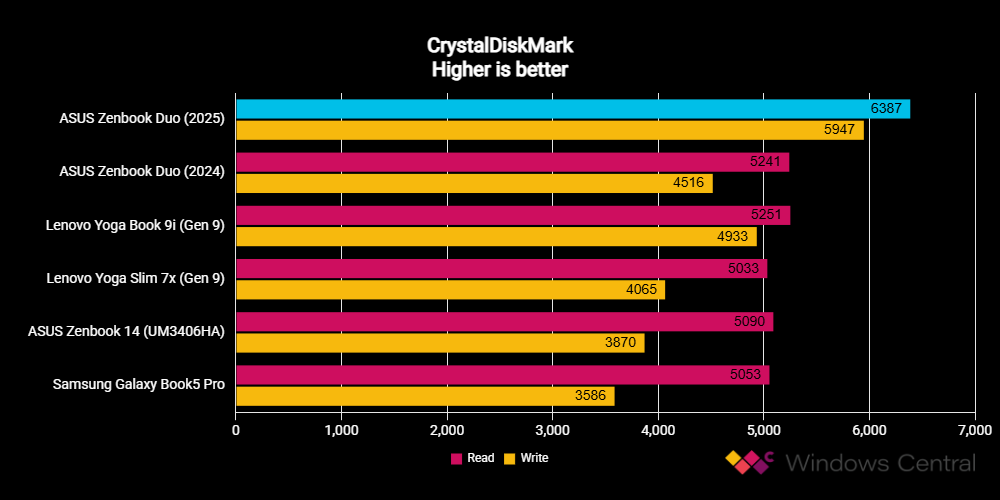
I put the 2025 ASUS Zenbook Duo through our usual benchmarking process, eager to see how much of an improvement Intel's Core Ultra Series 2 chips represent, powerful NPU or not. Unsurprisingly, the Core Ultra 9 285H comes out ahead of the Core Ultra 9 185H in all performed CPU-centric tests, including Geekbench 6, Cinebench 2024, and 3DMark Time Spy (which measures the integrated GPU).
The above results were achieved with the laptop set to Best Performance on AC power, but I also took a look at how much of a power drop there is when the laptop is unplugged. Laptops will often under-tune hardware as soon as it switches to DC power, boosting battery life artificially in the face of underwhelming performance. That's not the case here.
I saw a 2,791 single-core score and a 15,114 multi-core score on AC power, dropping only to 2,307 and 14,729 on DC power. SSD read and write speeds stayed the same, and even the integrated GPU hardly dropped off at all in Time Spy testing (4,432 compared to 4,368). Those are not huge differences, and you should expect a laptop that feels snappy whether it's on the charger or not.
It's interesting to note that AMD's Ryzen AI 9 HX 370 easily outperforms the Core Ultra 9 285H in the CPU benchmarks, all with an NPU powerful enough for Copilot+. You'll also notice the Snapdragon X Elite (X1E-80) in the Surface Laptop 7 we reviewed coming out ahead of the Core Ultra 9 285H in Cinebench 2024, falling behind slightly in Geekbench 6.
Intel boosted its integrated Arc 140T this time around, scoring about the same as an RTX 3050 Laptop GPU in 3DMark Time Spy.
As for the Apple M4 chip in the MacBook Pro 14, it easily outperforms the Core Ultra 9 285H in Geekbench 6 single-core scores, drawing much closer when all cores are engaged.
Intel boosted its integrated Arc 140T this time around, scoring about the same as an RTX 3050 Laptop GPU in 3DMark Time Spy. That's downright impressive, and anyone who wants to game a bit on the Zenbook Duo shouldn't be shy. Just watch out for overheating (more on that in the next section.)
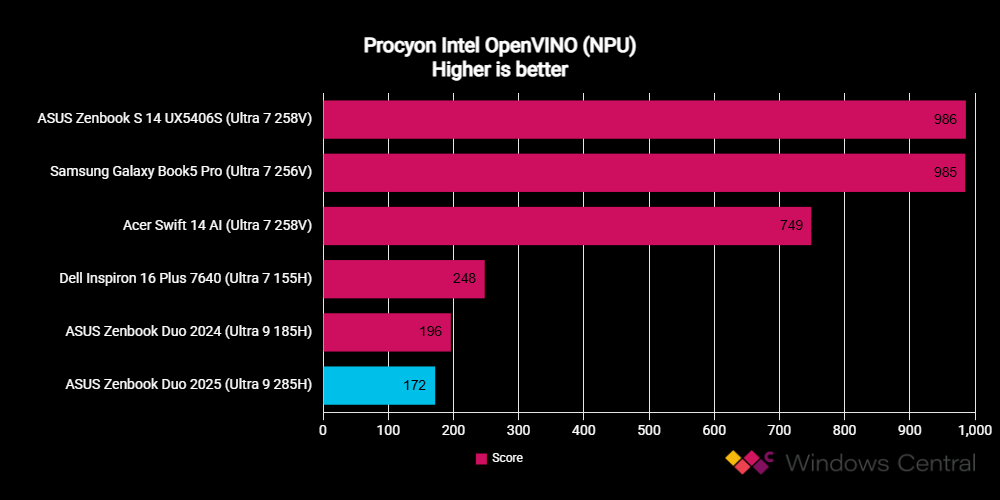
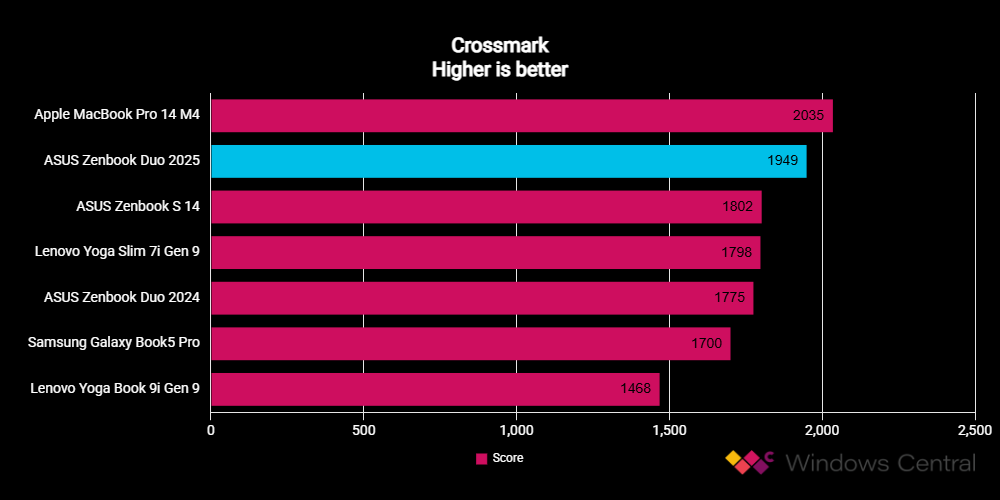
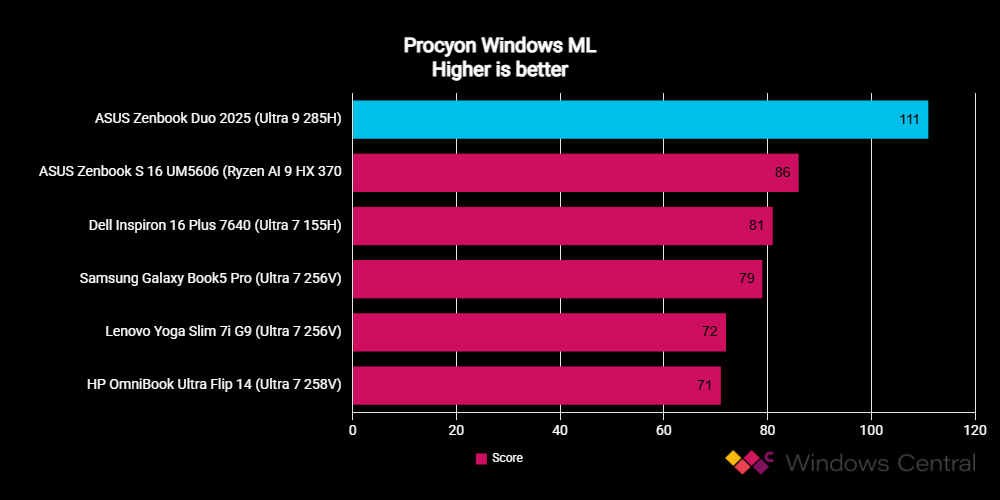
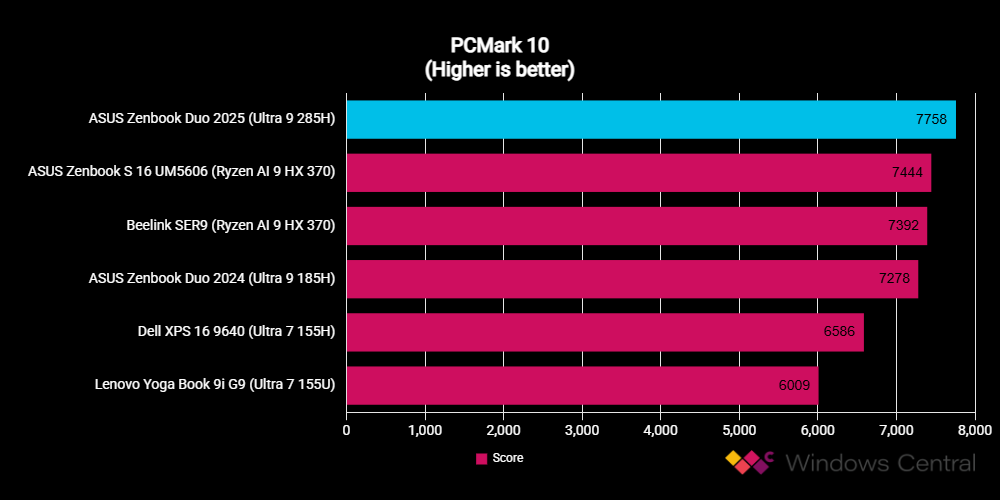
Crossmark gathers information from each component and awards an overall score for system performance rather than focusing on the CPU. Only the MacBook Pro 14 M4 beat the Zenbook Duo's Ultra 9 285H, and the difference is less than 100 points.
Despite the NPU's relative impotence, I also put the laptop through some of Procyon's AI benchmarks. In Windows ML, which measures machine-learning performance on Windows PCs using a combination of hardware, the Zenbook Duo easily beat the ASUS Zenbook S 16 UM5606 using a Ryzen AI 9 HX 370 CPU.
However, Procyon's Intel OpenVINO test that targets the NPU shows just how little of a focus there is on AI with Intel's H-series chips. The Core Ultra 9 285H scored less than the Ultra 9 185H, and it's easily beaten by the other laptops we've tested. It's an AI PC, but just barely.
Putting the AI stuff aside, the Core Ultra 9 285H is a chip offering excellent performance on AC or DC power, and the integrated GPU has now arrived roughly at where the RTX 3050L sits. That's quite impressive. It makes the laptop feel snappier overall — especially when switching windows and modes — and, as I'll explain in the next section, there really isn't a noticeable hit to battery life.
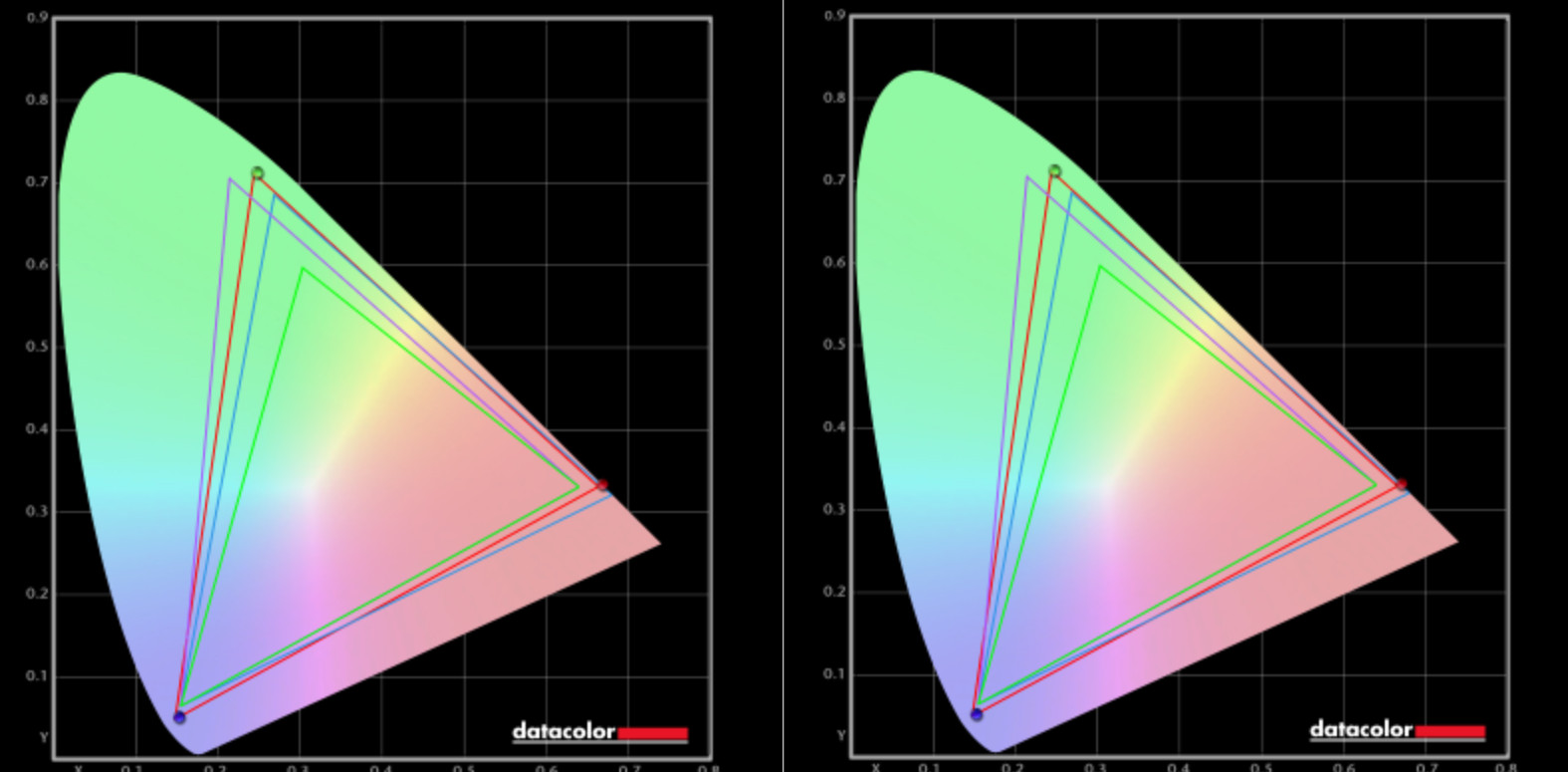
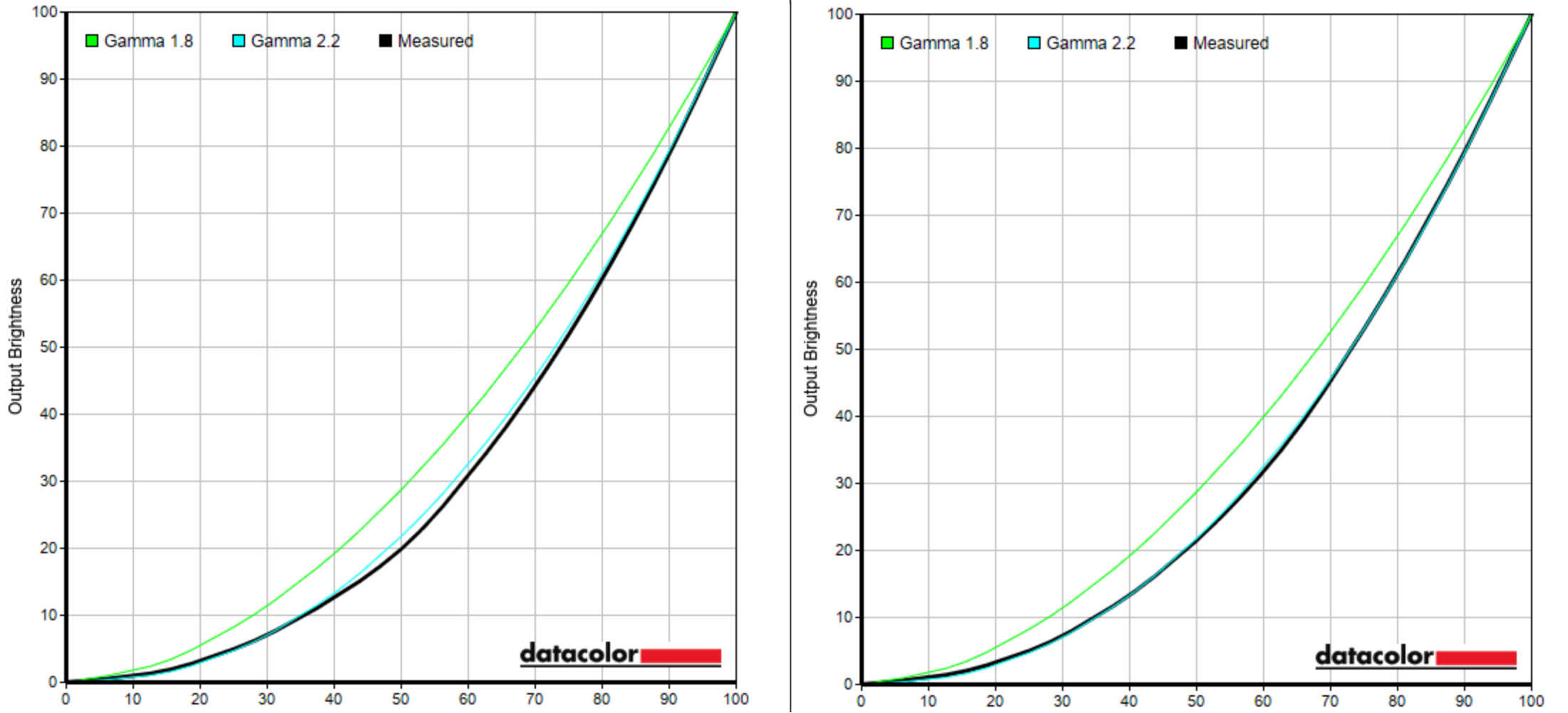
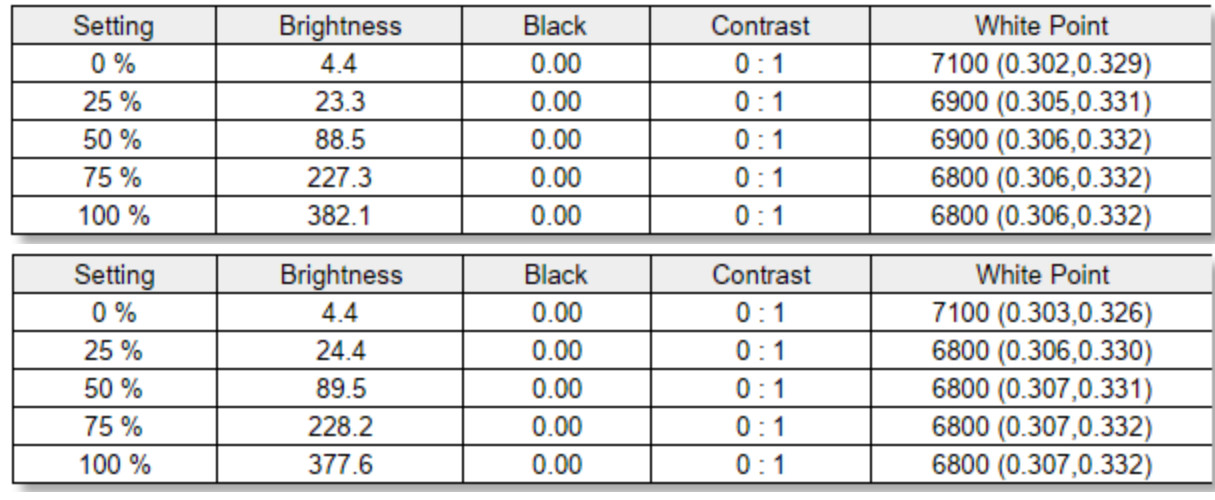
Ben Wilson discovered that the 2024 ASUS Zenbook Duo's OLED touch displays weren't identical, and that remains true for the 2025 model. However, the differences are even slimmer this time around.
Both screens in the 2025 model offer the same 100% sRGB, 95% AdobeRGB, and 98% DCI-P3 color reproduction, as well as practically identical tone response. Brightness drops to the same 4.4 nits at the lowest point, with the top screen hitting 382 nits at max. The bottom screen reached 377.6 nits at max, which isn't really noticeable to the naked eye.
The OLED screens look fantastic, especially when they dynamically switch to 120Hz on AC power.
Bottom line? The OLED screens look fantastic, especially when they dynamically switch to 120Hz on AC power. ASUS has not skimped on its displays at all, and you can expect the same greatness from both.
The ASUS Pen 2.0 adds inking abilities, which add just another way to interact with the PC. The only drawback is a glossy finish that shows more glare than usual. Something that's more anti-reflective would go a long way.
Zenbook Duo UX8406 (2025): Battery life and thermals
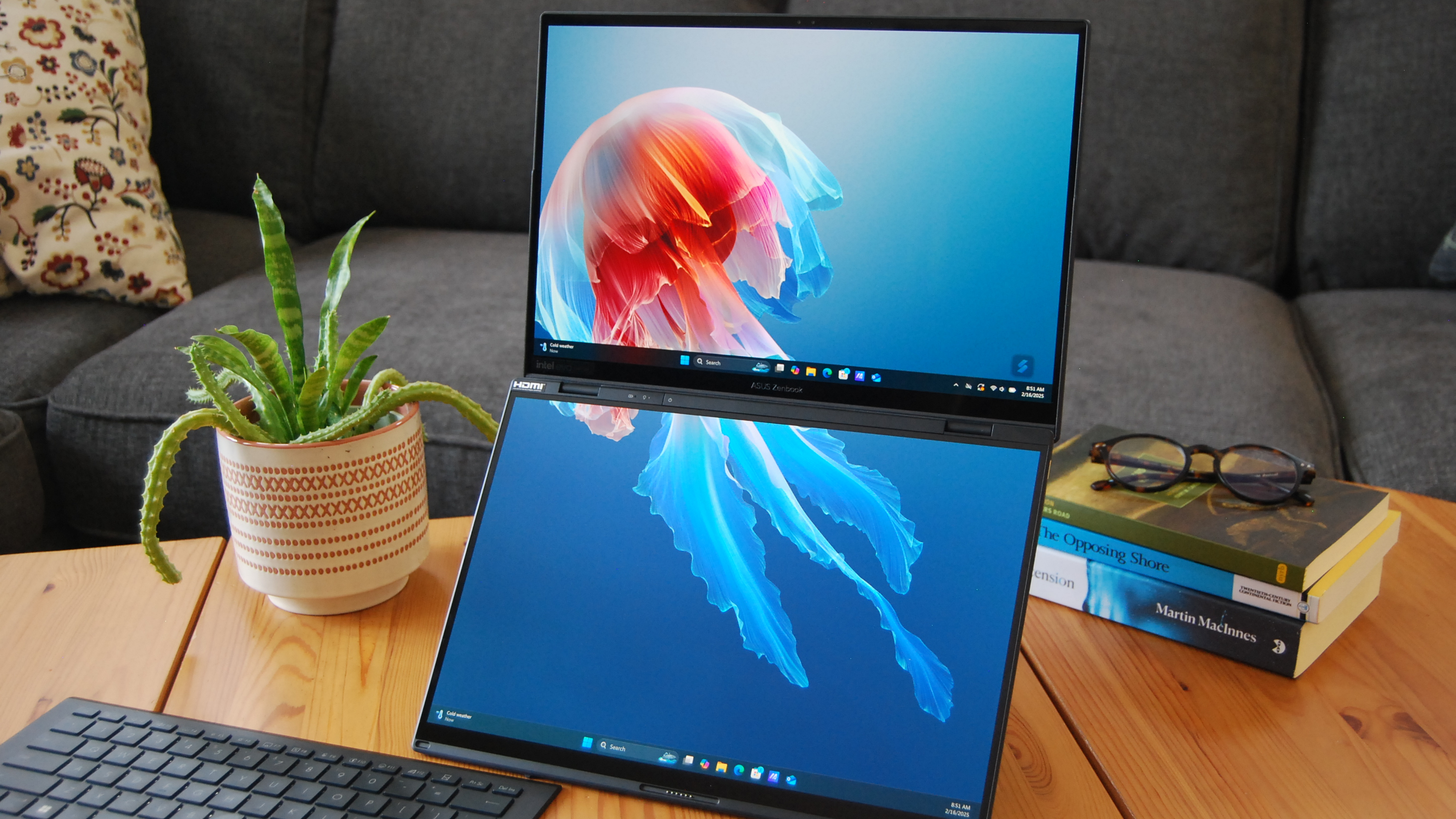
Ben Wilson tested the original Zenbook Duo's battery using Windows 11's "Balanced" power profile, with the screen set to about 200 nits and only the top screen active. He saw 11 hours and 30 minutes of runtime in PCMark 10's Modern Office rundown, which I consider an excellent result.
For the 2025 model, I put it through the same test, albeit with the Windows 11 set to "Best Performance." I got back 11 hours and 36 minutes, practically the same result but with a more potent power profile. Anything that survives over 8 hours of constant use, even if it never reaches maximum performance, is respectable. And considering you won't really experience a slowdown on DC power, the Zenbook Duo is better prepared than ever for a life of multitasking.
This laptop has two screens, and I re-ran the test with the keyboard set off to the side and both OLED displays enabled. The runtime dropped to 7 hours and 37 minutes, still a great result. The included 65W AC adapter is compact and offers fast charging abilities for the PC.
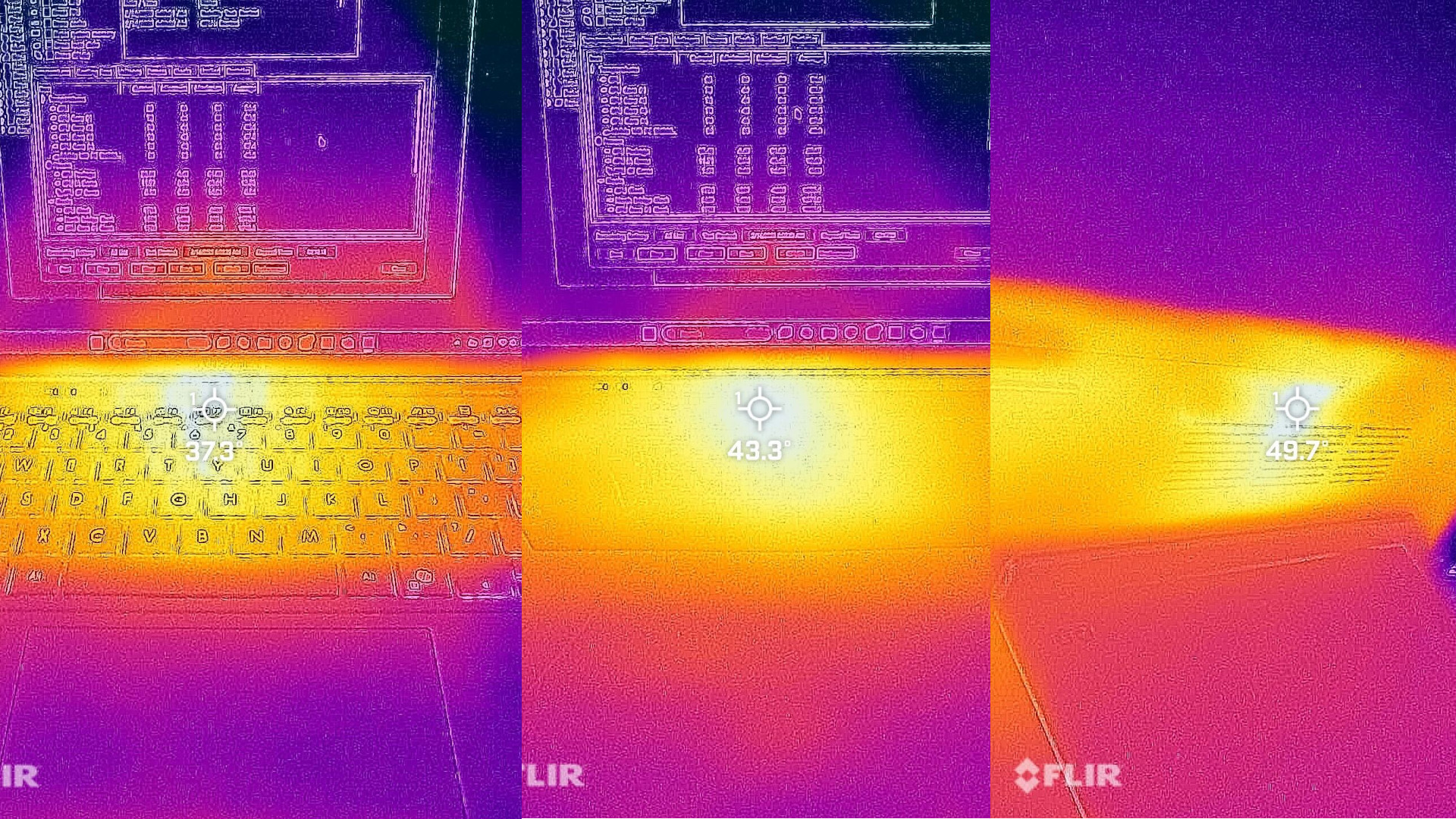
I ran a prolonged stress test on the system to see how well the cooling works. During the Core Ultra 9 285H's Turbo boost period, there was reported about 11% throttling, but it was merely a blip on the otherwise steady performance that saw no further throttling.
Fan noise is far from egregious, hitting about 50dBa — no louder than the ambient noise in an office — when under full load for 30 minutes. That's a lot better than I was expecting, considering how small the air intake is on the laptop. CPU temps remained below 60°C, leveling out to a 30W power draw following the Turbo boost.
With the PC still performing the stress test, I used my FLIR camera to check out the laptop's hot spots. Keep in mind that I'm looking at the worst possible scenario here, with the system under a simulated full load for an extended period. Unsurprisingly, it's hottest on the bottom panel, hitting about 50°C. You can see exactly where the CPU sits inside with the FLIR imaging.
The bottom screen hits about 43°C at the top hotspot over the CPU when the keyboard is removed, and the side vents reach about 40°C. That's roughly the same as what Ben saw in the 2024 Zenbook Duo, and it's well within reasonable limits. Using the laptop regularly for my workflow involving heavy web browsing, multitasking with many windows, and some photo editing never caused it to break a sweat.
Naturally, using the detachable keyboard separately puts you in no danger of feeling discomfort from heat, and attaching it to the chassis still benefits from the OLED panel separating it from direct content with any conductive parts.
Zenbook Duo UX8406: Camera and audio

The 1080p webcam with IR for Windows Hello is still just so-so with no upgrade compared to last year. I would have liked to see at least the addition of a webcam shutter. It'll do for occasional video meetings, but anyone operating with a webcam enabled most of the time will either want to find a great laptop for video conferencing or a standalone webcam.
One issue involving slow IR activation for Windows Hello during a clean boot of the PC seems to have been cleared up. Logging in with facial recognition is now just as fast (read: nearly instant) whether you're waking the laptop from sleep or powering it up afresh.
The laptop's speakers seem to be a bit louder in the refreshed model, but sound, to me, is still on the flimsy side despite Dolby Atmos tuning doing a lot of heavy lifting. This is where Ben and I disagree. He stated that they sound "fantastic for all kinds of audio," while I contest that they're fine for occasional meetings and for listening to music while you work.
Zenbook Duo UX8406 (2025): The competition
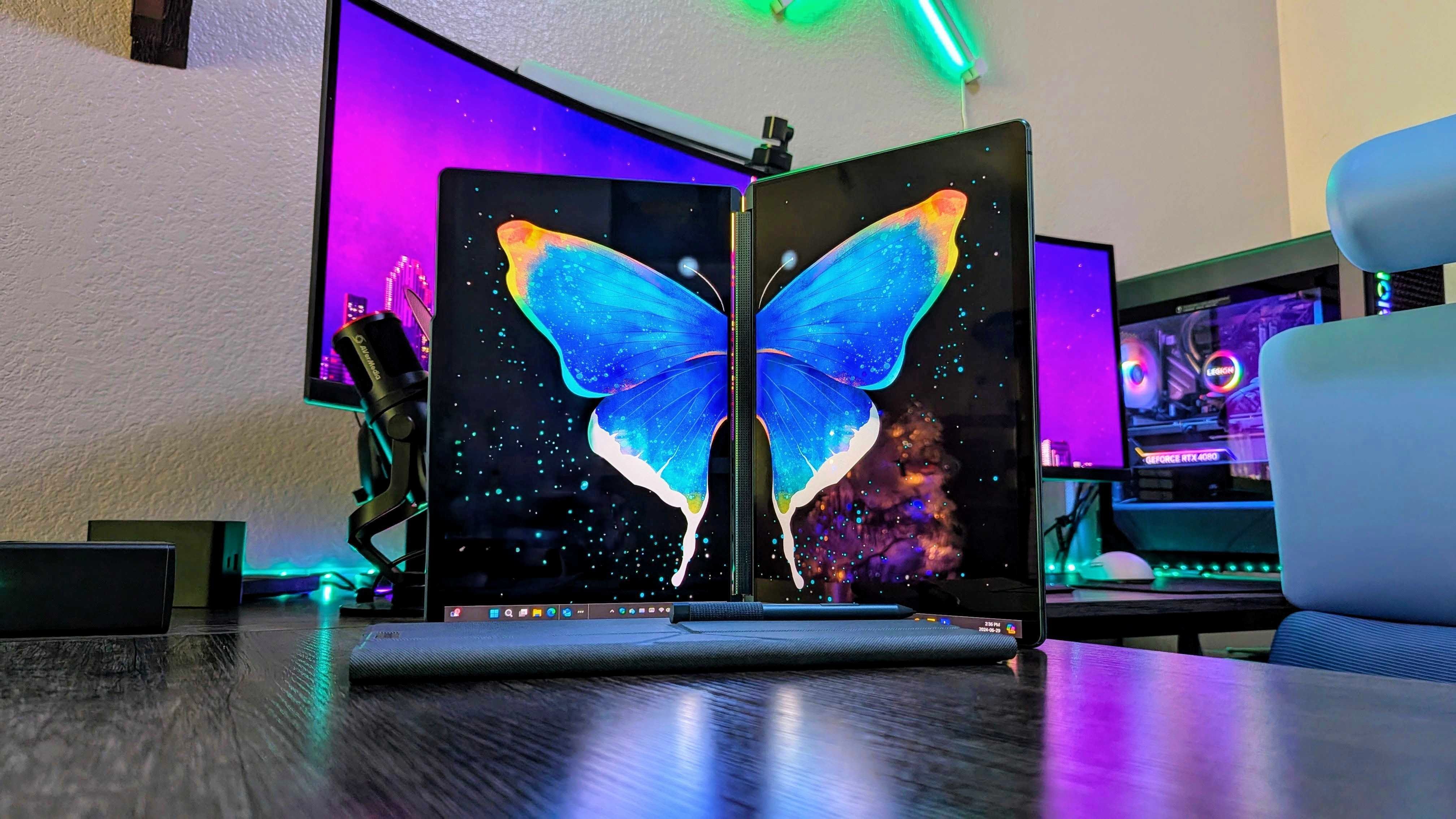
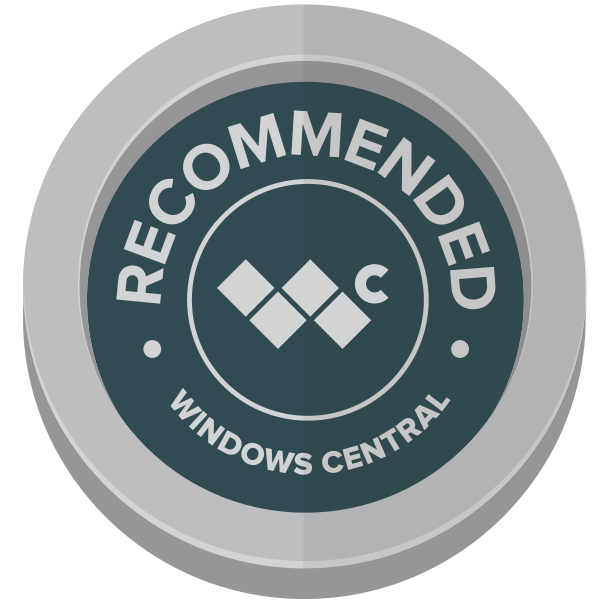
Dual-screen laptops are rare, and the only real competition for the ASUS Zenbook Duo is Lenovo's Yoga Book 9i. Lenovo has been refining its dual-screen laptop for years, and it's expected to enter its tenth generation later this year with a larger 14-inch display and Intel's Core Ultra 7 255H CPU.
Zachary Boddy reviewed the Yoga Book 9i (Gen 9), remarking:
"The Lenovo Yoga Book 9i (Gen 9) is great in some ways, average in others, and compromised in the remaining. It's a flawed mixture that's redeemed by the appeal of its dual-screened form factor. I very quickly got used to being able to spread my apps, browser tabs, and files across both screens when working, even with the performance issues. Whether you're willing to put up with that for $1,999.99 at Lenovo, though, is entirely up to you."
The Yoga Book 9i is more geared toward luxury than productivity, and its pieces don't fit together as well as in the Zenbook Duo.
I agree with Boddy's analysis. The Yoga Book 9i is more geared toward luxury than productivity, and its pieces don't fit together as well as in the Zenbook Duo. Sure, the Yoga Book 9i is slimmer, but the keyboard and stand are separate components that you must keep track of when you're on the move. The higher price also won't sit well with many users who simply want a functional dual-screen setup without a ton of premium bells and whistles.
I look forward to seeing the Yoga Book 9i (Gen 10)'s changes when it launches later this year, as Lenovo is clearly looking to eat some of the Zenbook Duo's lunch with larger displays and a more powerful chipset.
Zenbook Duo UX8406 (2025): Score card
Attribute | Rating & notes |
|---|---|
Value | 5/5 — You'll spend more compared to a single-screen laptop, but for $1,600 you can get two OLED displays, a Core Ultra 7 255H, 32GB of RAM, and 1TB SSD. $100 more gets you a Core Ultra 9 chip. Not bad at all. |
Design | 5/5 — The Zenbook Duo is simply fun to use, it's built well with MIL-STD durability certification, and all parts come together for easy transportation. |
Display | 5/5 — Dual 3K OLED touch displays. Enough said. |
Performance | 4/5 — The Core Ultra 9 285H is a real performer, though it's bested by modern AMD and Qualcomm hardware. It also lacks a powerful NPU. |
Battery | 5/5 — Battery life remains roughly the same as the last generation, but you get higher performance. |
Keyboard & touchpad | 5/5 — I love typing on this keyboard, attached or detached, and the touchpad has a firm click. It's a wonder how ASUS assembled such a fine set of keys on such a thin slab. |
Other features | 3/5 — The 1080p webcam lacks a shutter and is just average in terms of picture quality. The speakers are louder than last year, but they're still on the flimsy side. |
Overall | 4.5/5 — The Zenbook Duo (2025) is as easy to recommend as its predecessor, and it continues to be the best dual-screen laptop on the market, flaws and all. |
Zenbook Duo UX8406 (2025): Should you buy it?
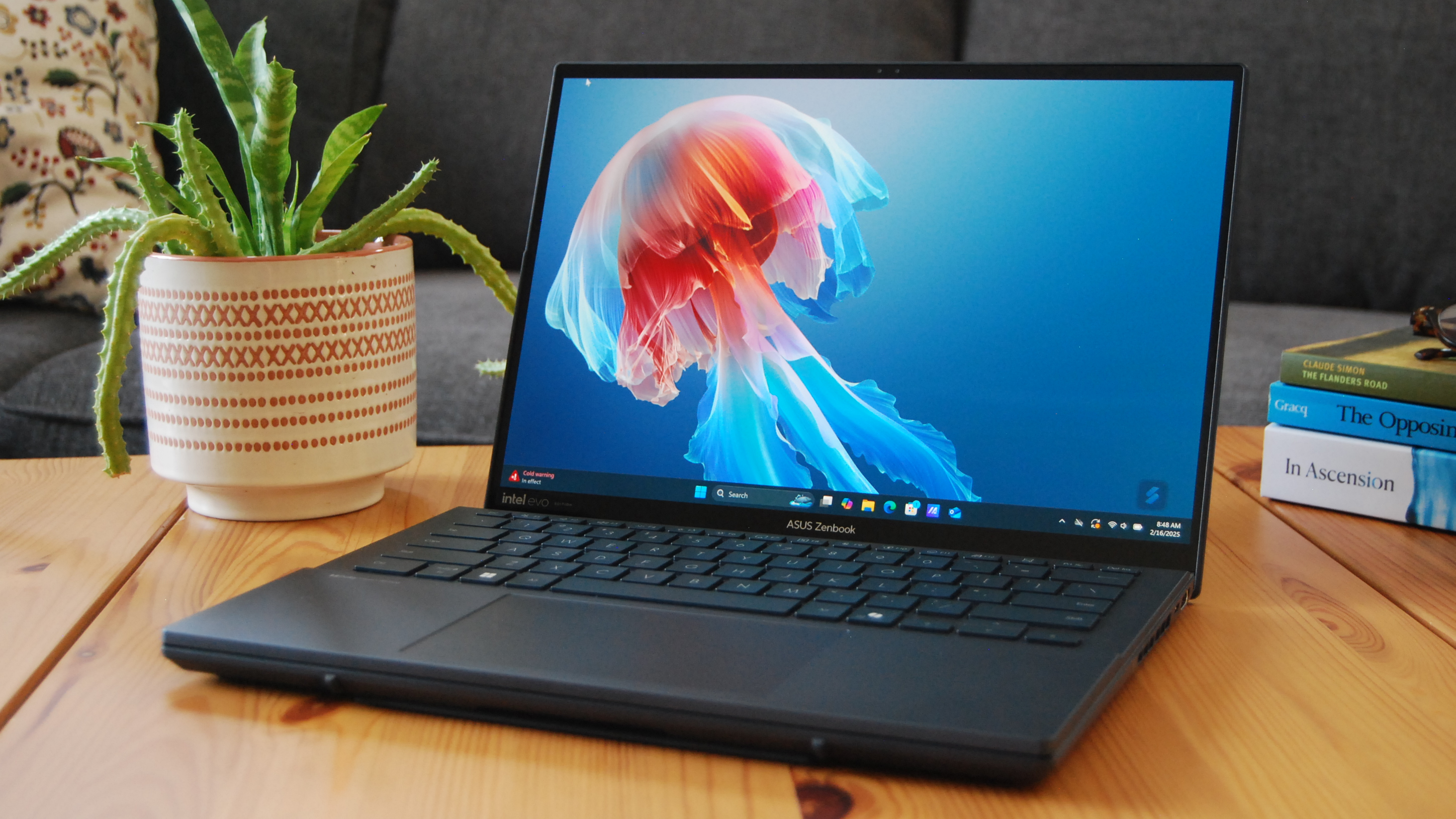
You should buy this if ...
✅ You want a versatile laptop
Touchscreens are often a gimmick unless they offer a genuine benefit. The Zenbook Duo pulls off a virtual keyboard, trackpad, and stylus input combination that excels in multiple ways. You'll need the desk space, but it's a joy to use.
✅ You're a traveling professional
ASUS could have left its 'sharing mode' as a side effect of offering two touchscreens. However, adding a stylus makes it viable for collaborating and quickly showing presentations in otherwise unusual work environments. It's more than a simple markup tool.
You should not buy this if ...
❌ You travel light
14-inch laptops are targeted almost exclusively at traveling tech enthusiasts, but the Zenbook Duo has to trade extra weight for its double-screen benefits. It's not extremely heavy, but it'll likely weigh down a carry-on bag to the point of annoyance.
❌ You're a video-centric content creator
While the stellar audio playback and stylus input are valuable for creatives working with images and video, the lackluster webcam won't serve well enough for those interested in travel vlogging alongside content creation without an external camera.
Last year, ASUS turned me onto its often-eccentric catalog of high-end hardware by packaging a genuinely useful combination of gorgeous OLED touchscreens into a subtle chassis. The 2024 Zenbook Duo was (and still is) a fantastic laptop that practically never faltered during my testing, leaving only a desire for a better webcam and an Ethernet adapter freebie thrown in the box. It's not perfect, but it's as close as you can get in this price range, and I'd heartily recommend it among the best 2-in-1 laptops we've ever tried.
Updates to the 2025 model only improve the Zenbook Duo.
Updates to the 2025 model only improve the Zenbook Duo. The new Intel Core Ultra 9 285H outperforms its 185H predecessor, and battery life has slightly improved. Models start at $100 more than before, but that extra cost bumps the display resolution up to 3K rather than FHD+. Not a bad deal.
Like the first Zenbook Duo (UX8406), the 2025 model is just plain fun to use. I have more ideas on how best to use this clever screen combination every few minutes, and so far, it's worked brilliantly on almost every occasion. If it's within your budget, you won't regret picking up this triumphant 2025 revision of the Zenbook Duo.

Cale Hunt brings to Windows Central more than eight years of experience writing about laptops, PCs, accessories, games, and beyond. If it runs Windows or in some way complements the hardware, there’s a good chance he knows about it, has written about it, or is already busy testing it.
You must confirm your public display name before commenting
Please logout and then login again, you will then be prompted to enter your display name.
